#islamabad model town
Text









Honda Grace
Model Year:2019
Import Year:2022
Applied for Registration
Mileage 13,000
Auction Sheet 4 grade
Push Start
Beigh room
Cruise control
Multimedia
Climate Control
Andriod Panel
Leather Seats
Leather Steering
Multimedia Steering
Back View Camera
Alloy Rims
And Much More ...
Contact:- Hammad Mansoor
📱 03000300001
🤳 03-111-383-333
Showroom Address📍:
Sigma Motors Lahore: 382-E Main Boulevard near Allah Ho Chowk Johar Town.
- - - - - - - - - - - - - -
Instagram / Facebook / TikTok / Twitter / Tumblr / YouTube: @Sigma_Motors
🌐Website: https://www.sigmamotors.pk/
- - - - - - - - - - - - - -
#SigmaMotors #japanesecars #islamabad #pakistan #sialkot #faislabad #pakistanzindabad #lahore #importfromjapan #importcars #quetta #japan #pakistancars #japanesecar #igpakistan #pakistangram #carsofinstagram #cardealer #importedcars #freshimport #gujranwala #freshimports #grace #NissanGrace #Nissan #carsales #sigmamorotslahore #Grace
0 notes
Text
Rain, flashfloods wreak havoc in Balochistan: 7 dams torn apart

Interfacing street of Pak-Afghan town separates: Several bordering regions immersed as Tangi Dam in Qila Saifullah breakdowns: Mardan confronting danger of metropolitan flooding: Warning for land sliding in AJK gave: Army salvages 4 individuals adhered in Khushab because of overwhelmed nullah: Karachi, Islamabad, Lahore and a few different urban communities get weighty showers: Crops overflowed because of channel break in Tangwani
Heavy rains and resulting floods have unleashed devastation in Balochistan as the loss of life has reached 54. A few dams have destroyed in the territory where salvage endeavors are in progress directly following enormous scope obliteration, revealed Local TV channel on Saturday.
As per reports, Tangi Dam in Qila Saifullah has been broken immersing a few bordering regions. Numerous streets interfacing Pak-Afghan town have been drooped.
A dam in Kan Mehitar Zai has fostered a break. Other than this, 7 dams in Pishin, Muslim Bagh, Qila Abdullah and Zhob have destroyed.
The organization has cautioned that the constant spell of downpour in Toba Achakzai could separate a dam around there. Practically half apple trees have been washed away in the flashfloods nearby.
The overwhelmed occupants have engaged the specialists to give free clinical camps and food nearby.
Kohlu circumstance
The neighborhood organization is effectively taken part in salvage endeavors in Kohlu - the most obviously terrible hit area of Balochistan.
The organization is sans conveying tents, food and different articles among the downpour and flood affectees.
DC Qurban Ali said that the public authority wouldn't abandon the afftectees. He said groups had been framed to evaluate the harm.
Upwards of 2 individuals have kicked the bucket while 8 others harmed such a long ways in the destruction brought about by the new rains and floods. The downpour water has additionally annihilated the standing harvests and correspondence framework.
Mardan confronting metropolitan flooding in the midst of weighty downpours
Because of weighty spell of storm downpours, Mardan is confronting danger of metropolitan flooding.
As indicated by the Pakistan Metrological Department, Mardan will get weighty showers that could prompt spilling over of its streams and nullahs.
Mardan Deputy Commissioner Habib Ullah Arif has given a notice guiding all divisions and officials to be on their toes every minute of every day to manage the crisis circumstance.
The DC has coordinated the authorities of sterilization administrations organization and TMAs to guarantee the neatness of channels and siphoning of water from the city roads during precipitation, DC representative said.
He said that the DC had trained the water system division to eliminate all infringements on Kalpani nullah and different channels in case of conceivable flooding.
The crisis control room of the city has been made dynamic under the reconnaissance of the delegate magistrate.
Armed force helping in salvage endeavors
In the mean time, the Pakistan Army authorities are assisting the common organization with protecting individuals trapped in the overflowed regions.
The FC men protected 4 individuals abandoned in overwhelmed Kech Kor Nullah in South Bulen area of Khushab.
Downpour circumstance in Karachi
Karachi today got one more innings of torrent as Sadr, Clifton, Cantt Station and Kala Pul were hit by weighty deluge.
Police have shut all sides of Causeway as Korangi Causeway stream is in flood. The suburbanites need to utilize a redirection to arrive at Korangi Industrial Area because of conclusion of the Causeway.
The City of Quaid was at that point faltering from the previous weighty slush which has transformed numerous regions into colossal pools and streams.
Downpour water has previously lowered Model Colony, Malir and Airport Road. The organization has introduced siphons at better places to empty water out of roads.
Numerous regions hit by weighty showers
As per the climate projection, irregular downpour will pound numerous urban areas the nation over including Karachi and Islamabad today.
A weighty downpour beat Lahore, Gujranwala, Daska, Narowal, Sialkot and Faisalabad. Gujrat and Jehlum additionally got downpour.
The Pakistan Metrological Department has anticipated weighty downpour in Peshawar, Noshera and Mardan.
It has additionally conjecture heavy rains in numerous areas of Azad Kashmir including Kotli where streams and nullahs could confront flooding. There is likewise an admonition of land sliding in these spots.
In Interior Sindh, there is downpour gauge in Hyderabad, Pirpurkhas, Badin and Dadu.
Met office says that numerous urban communities in Balochistan including Quetta will be barreled by slush.
Crops overflowed because of waterway break in Tangwani
Ranchers in town Muhammad Ameen Jaffery close to Tangwani, region Kashmore Sindh have experienced the deficiency of billions of rupees after the rice crop developed more than many sections of land of land was immersed with water following the improvement of a 25-feet wide break in Musa Allahabad Canal because of weighty downpours nearby, revealed Local TV channel on Saturday.
Also, it doesn't stop here as the water is quick towards neighboring territories, spreading dread and frenzy in the occupants.
Also, to exacerbate the situation, the water system division staff has not arrived at the site at this point to plug the break, passing on local people to stop the progression of water all alone.
This is for the second opportunity in seven days that a break has created in Musa Allahabad Canal, which has made the deficiency of billions of rupees local people.
Read the full article
0 notes
Text
Free power for those using up to 100 units: Hamza Shahbaz
Free power for those using up to 100 units: Hamza Shahbaz
Punjab CM Hamza addressing a press conference in Lahore on July 4, 2022. Photo: APP
LAHORE/ISLAMABAD: Punjab Chief Minister Hamza Shehbaz announced on Monday the provincial government would bear the power cost of households consuming up to 100 units of electricity in a month.
Addressing a press conference at Model Town, he said, “I was told not to take big decisions without the cabinet consent…
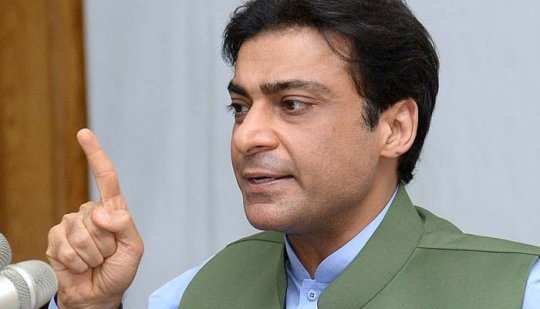
View On WordPress
0 notes
Text
Deemak Control Termite Control Services & Pest Control Services Islamabad Lahore
Searching for Exterminator Pest Control Near Me? We provide Pest Control Services and Termite Control Services, including Deemak Control in Lahore, Fumigation Spray Services, Bed Bug Infestation Treatment, Cockroach Control Services, and Rats Trapping Services, and Termite Proofing Spray for Termites Treatment. 😲
#PestControlServicesInLahore #DeemakControlInLahore #TermiteControlServicesInLahore #PestControlServices #PestControlIslamabad #TermiteControlIslamabad #FumigationSprayServicesIslamabad #PestControlNearMe #ExterminatorInLahore #HerbalPestControlCharges #BedBugInfestationTreatment #BedBugsKillerSprayServices #CockroachKillerSpray #CockroachControlServices #RatsTrappingServices #RatKillPoison #TermiteProofingSprayForTermites #FumigationServicesInRawalpindi #IntegratedPestManagement #SanitizationDisinfectionServices #SofaCleaningServicesInIslamabad #DengueSprayInLahoreIslamabad #MosquitoKillerSpray #PestManagementServicesInLahore
Web: https://hafizpestcontrol.com/ 👈
Phone: +92 300 4888279 😍

### Deemak Pest Control Services in Lahore By HafizPestControl ###
As an Exterminator pest management team, we, the Hafiz Pest Control Company, provide Pest Control Services in Lahore, Deemak Control in Lahore, and Termite Control Services in Lahore
## Our Pest Control Services Includes: ##
Pest Control Services in Lahore
Deemak Control in Lahore
Termite Control Services in Lahore
Pest Control Services
Pest Control Islamabad
Termite Control Islamabad
Fumigation Spray Services Islamabad
Pest Control Near Me
Exterminator in Lahore
Herbal Pest Control Charges
Bed Bug Infestation Treatment
Bed Bugs Killer Spray Services
Cockroach Killer Spray
Cockroach Control Services
Rats Trapping Services
Rat Kill Poison
Termite Proofing Spray for Termites
Fumigation Services in Rawalpindi
Integrated Pest Management
Sanitization Disinfection Services
Sofa Cleaning Services in Islamabad
Dengue Spray in Lahore Islamabad
Mosquito Killer Spray
Pest Management Services in Lahore
Phone: +92 333 0138282 🆗
Q-Block, Model Town Extension, Lahore, Pakistan
#Pest Control Services in Lahore#Deemak Control in Lahore#Termite Control Services in Lahore#Pest Control Services#Pest Control Islamabad#Termite Control Islamabad#Fumigation Spray Services Islamabad#Pest Control Near Me#Exterminator in Lahore#Herbal Pest Control Charges#Bed Bug Infestation Treatment#Bed Bugs Killer Spray Services#Cockroach Killer Spray#Cockroach Control Services#Rats Trapping Services#Rat Kill Poison#Termite Proofing Spray for Termites#Fumigation Services in Rawalpindi#Integrated Pest Management#Sanitization Disinfection Services#Sofa Cleaning Services in Islamabad#Dengue Spray in Lahore Islamabad#Mosquito Killer Spray#Pest Management Services in Lahore#PestControlServicesInLahore#DeemakControlInLahore#TermiteControlServicesInLahore#PestControlServices#TermiteControlIslamabad
0 notes
Text
#real estate#real estate agency#real estate agents#real estate company#property#marketing#advertising#home & lifestyle#news#plots#apartments#villas#home#house#real estate market#pakistan#islamabad#rawalpindi#islamabad model town#model town islamabad#model town pakistan#islamabad model town 2022#islamabad model town housing scheme
1 note
·
View note
Photo
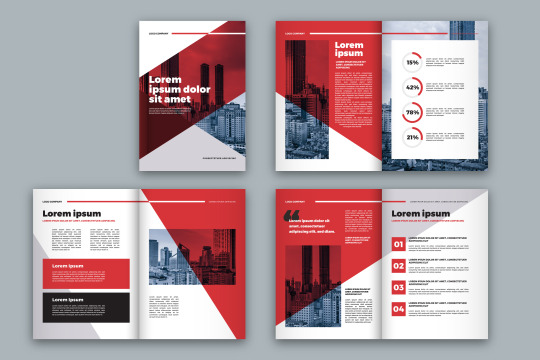
Jackpot Pakistan | Best Magazine Marketing Services | Best Spot For Ads
Jackpot pakistan, The best advertisement company offering the best places to show your ads on different platforms. We aware your brand to the world through our jackpot Pakistan magazine.
Jackpot Pakistan Company advertise your content to get thousands of people to your business. You get more engagement with this marketing strategy. We do it by placing your ads on our jackpot magazine that is the best places for your ads.
The magazine marketing strategy can work with local marketing businesses to listed your business name in the top business industries.
Our Top Magazines Are:
Bahria Town Magazine
Model Town Magazine
Sukh Chayn Garden Magazine
DHA Lahore Magazine
#bahria town#sukh chayn#model town#dha#dha lahore#dha karachi#dha islamabad#dha magazine#magazine#jackpot#jackpots#jackpot magazine#pakistan magazine
0 notes
Photo
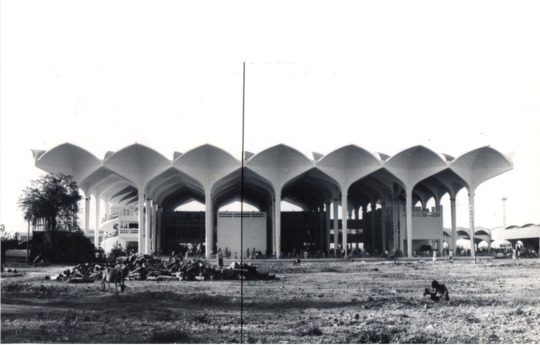
Kamalapur Railway Station in Dhaka
Architectural Optimism of Bangladesh
Saša Šimpraga, 2021.
Adnan Zillur Morshed is an architect and architectural historian with focus on history and theory of modern architecture and urbanism; global history; urban poverty and spatiality; water and architectural historiography; and ecological urbanism in developing countries. He received his Ph.D. and Master’s in architecture from MIT and completed his pre-doctoral studies at the Center for Advanced Study in the Visual Arts at the National Gallery of Art and postdoctoral under Verville Fellowship at the National Air and Space Museum in Washington, DC.
Morshed is the author of several books among other: Impossible Heights: Skyscrapers, Flight, and the Master Builder which examines the American fascination with the skyscraper and the airplane as part of a widely shared cultural phenomenon--the aesthetics of ascension--that characterized the interwar period. His books also include DAC, Dhaka through Twenty-Five Buildings.
He is a professor at the School of Architecture and Planning of the Catholic University of America in Washington, D.C.
Adnan Morshed is also involved with local and international intiatives on preservation of modernist architectural heritage of Bangladesh. We talk to him on the occasion of current international appeal to save the Kamalapur Railway Station in Dhaka from demolition.
SŠ: A gem of the Modern Movement in South Asia, The Kamalapur Railway Station in Dhaka, designed by Daniel Dunham and Robert Boughey in the 1960s is threatened due to the an urban expansion plan of the Dhaka Metro Rail's Line that includes its demolition and replacement by a new infrastructure, rather than its adaptation. What is the significance of the building and its current status?
Adnan Morshed: Kamalapur Railway Station is a rare modern train station in South Asia. It adopts an aesthetic vocabulary of tropical modernism for a public building in ways that have not been seen before in the region. The station’s modernist architecture breaks with colonial precedents both in the imperial center and on the subcontinent. In London, St. Pancras Station (1863–76) encapsulated modern values of mobility and exchange, while the Chhatrapati Shivaji Terminus (formerly Victoria Terminus; built in 1888 and now a UNESCO World Heritage) in Mumbai and Howrah Station (1906) in Kolkata functioned as symbols of imperial hegemony.
The histories of colonialism and train infrastructure are deeply intertwined in South Asia. In 1862, the Eastern Bengal Railway Company opened the first railway line in the region from which it took its name. Connecting Kolkata with the western Bangladeshi town of Kushtia, this expansion of train services signaled a new phase in the growth of East Bengal’s colonial economy. Due to geographical challenges posed by Bengal's deltaic terrain, the railway did not arrive in Dhaka until the following century, after the city’s economic profile had risen and it was subsequently made, in 1947, the provincial capital of then-East Pakistan. In 1958, the government approved the creation of a new railway depot, which was inaugurated a decade later as Kamalapur Railway Station. Not only was it one of the largest modern railway stations in South Asia, but it also embodied changing conceptions of modernity, from the bracing mobility of 19th-century railways to the soaring modernism that defined the 1960s.
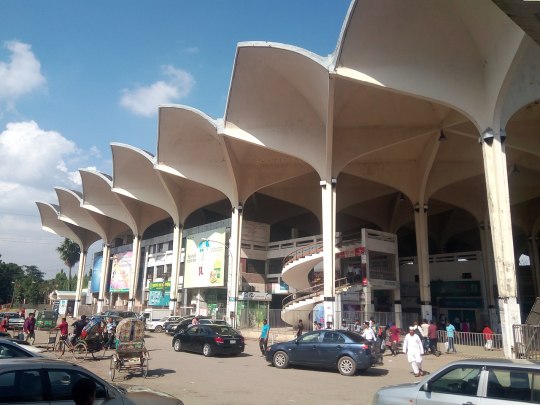
Kamalapur Railway Station, Photo by Anik Sarker/ Wikipedia
SŠ: Also in danger of demolition is the Dhaka University Teacher-Student Center Building by Greek architect Constantinos Doxiadis (the mastermind behind planning the city of Islamabad) from early 1960s. The structure exemplifies a modernist architectural sensitivity toward spatial needs for tropical climatic conditions. TSC's dome-shaped structure with empty spaces around is considered an iconic landmark not only inside Dhaka Uiversity campus, but in the broader cityscape of Dhaka. How optimistic are you about its future? And what is the general status of modernist architectural heritage of Bangladesh?
Adnan Morshed: I am concerned about the mid-20th-century buildings in Bangladesh because of the ways the notion of development is taking precedence over environment, history, and, generally, human wellbeing. Many buildings are about to face the wrecking ball. These buildings include the Teacher-Student Center or TSC. Located at the historic heart of the University of Dhaka, TSC exemplifies a type of tropical modernism that blends local architectural traditions of space-making—particularly the indoor-outdoor continuum and generation of space around courtyards—with the abstract idiom of the International Style. The complex of buildings was designed by the Greek architect, planner, and theoretician Constantinos Apostolos Doxiadis (1913–1975) in the early 1960s. This was a turbulent time marked by conflicting currents of political tension and architectural optimism in what was then East Pakistan, now Bangladesh. On the one hand, the two wings of postcolonial Pakistan were at loggerheads because of the political domination of East Pakistan by the military junta based in West Pakistan. On the other hand, many architectural opportunities arose in East Pakistan, which benefitted from American technical assistance. The United States allied with Pakistan as part of its Cold War-era foreign policy to create a geostrategic buffer against the socialist milieu of the Soviet Union–India axis in South Asia. Under the purview of a technical assistance program, the United States Agency for International Development and the Ford Foundation provided support for building educational and civic institutions in East Pakistan. Since there was a dearth of experienced architects in East Pakistan, the government sought the services of American and European architects for a host of buildings that were constructed during the 1960s. Doxiadis was among them.

TSC, Photo by Fasiha Binte Zaman/ Wikipedia
TSC is also a demonstration of Doxiadis’s idea of ekistics, by which he meant an objective, comprehensive, and integrative approach to all principles and theories of human settlements. Criticizing the top-down planning model which he viewed as a central problem associated with modernism, Doxiadis employed the notion of ekistics to promote a multidisciplinary, inclusive, and bottom-up approach. He hoped that such a method would create a synergy of local and global influences, by which one could successfully meld a data-driven theorization of planning, universal values of harmonious living, and place-based cultural inflections.
In this vein, Doxiadis aligned the TSC’s ensemble of buildings on an east-west axis, to take advantage of the prevailing breeze from the south or north. The three-story Student Union Building features a “double roof” that minimizes heat gain by allowing cool breezes to pass in between the two canopies. The ingenious solution proved to be a trendsetting feature, but it was just one of the complex’s many innovations. Doxiadis covered the auditorium with a reinforced concrete parabolic vault, a pioneering construction technique that had yet to be tested in the country. Covered walkways, supported on steel columns, weave together the major buildings and green spaces, serving as the social spine of the entire complex. In the post-Independence period, TSC became the epicenter of political agitation within Bangladesh, serving as a backdrop to political demonstrations.
SŠ: Pioneer od modernist architecture in Bangladesh, Muzharul Islam, began hes career in the 1950s. Born in 1923, he went to study architecture in the United States, and then returned to Bangladesh. Along with his teacher Louis Kahn, he also brought Paul Rudolph and Stanley Tigerman to work in Bangladesh, and three of them came to be known as the American Trio. Apart from the Trio, it was Islam's style that dominated Bangladesh architecture from 1950s onwards. What is his legacy in architectural history of Dhaka?
Adnan Morshed: Not only was architect Muzharul Islam Bangladesh's pioneering modernist architect, he was also an activist designer who viewed architecture as an effective medium for social transformation. His early work shows how architecture was deeply embedded in post-Partition politics.
Consider his “master piece,” the Faculty of Fine Arts (1953-56) at Shahbagh in Dhaka. At first encounter, the building presents the image of an international-style building, with a quiet and dignified attention to the architectural demands of tropical Bengal. Closer inspection, however, hinders the Eurocentric tendency to measure the building's “modernity” exclusively through a “Western” lens. A host of nuanced architectural modulations and environmental adaptations reveals how Muzharul Islam's work cross-pollinates a humanising, modernist architectural language with conscious considerations of climatic needs and local building materials.
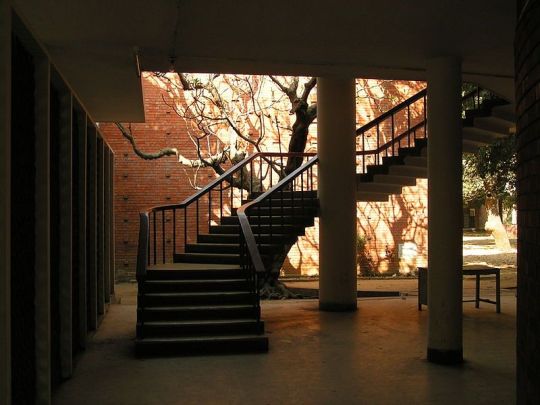
Faculty of Fine Arts, Photo by Rossi101/ Wikipedia
The literature on South Asian modern architecture usually identifies the Faculty of Fine Arts as the harbinger of a Bengali modernism, synthesising a modern architectural vocabulary with climate-responsive and site-conscious design programmes. What has not been examined in this iconic building is how Islam's work also provides a window into the ways his architectural experiments with modernist aesthetics were part of his inquiries into the ongoing politics of Bengali nationalist activism.
Muzharul Islam interpreted the prevailing political conditions in his homeland as a fateful conflict between the secular humanist ethos of Bengal and an alien Islamist identity imposed by the Urdu-speaking ruling class in West Pakistan. The turbulent politics in which he found himself influenced his worldview as well as his fledgling professional career. The young architect began his design career in a context of bitterly divided notions of national origin and destiny, and his architectural work would reflect this political debate. He felt the need to articulate his homeland's identity on ethno-cultural grounds, rather than on a supra-religious foundation, championed by West Pakistani power-wielders. Muzharul Islam's Faculty of Fine Arts embodied these beliefs.
With his iconoclastic building, Islam sought to achieve two distinctive goals. First, the building introduced the aesthetic tenets of modern architecture to East Pakistan. For many, its design signalled a radical break from the country's prevailing architectural language for civic buildings. These buildings were designed either in an architectural hybrid of Mughal and British colonial traditions, popularly known as Indo-Saracenic, or as utilitarian corridor-and-room building boxes, delivered by the provincial government's Department of Communications, Buildings, and Irrigation (CBI). The Faculty of Fine Arts was an unambiguous departure from the colonial-era Curzon Hall (1904–1908) at the Dhaka University, within walking distance of Islam's building, and the Holy Family Hospital (1953; now Holy Family Red Crescent Medical College Hospital).
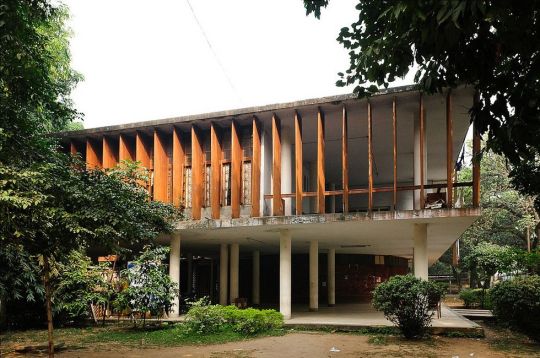
Faculty of Fine Arts, Photo: Wikipedia
Second, the Faculty of Fine Arts' modernist minimalism—rejecting all ornamental references to Mughal and Indo-Saracenic architecture—was a conscious critique of the politicised version of Islam that had become a state apparatus for fashioning a particular religion-based image of postcolonial Pakistan. By abstracting his design through a modernist visual expression, Muzharul Islam sought to purge architecture of what he viewed as the political associations of instrumental religion.
SŠ: Internationally, perhaps the most known modernist structure in Bangladesh is the National Parliament Complex, designed by Louis Kahn and associates. Its construction began in 1964, in what is now known as the Decade of Development for Bangladesh and time when Dhaka was the second capital of Pakistan. When talking about architecture in general, Muzharul Islam stated that „practical aspects of architecture are measurable – such as, the practical requirements, climatic judgments, the advantages and limitations of the site etc. – but the humanistic aspects are not measurable.“ Those aspects come when the architect leaves and building starts its life. How did that highly acclaimed complex came to be a part of the national identity and how its architecture influences culture in a broader sence?

National Parliament Complex in Dhaka, Photo: Yes, Louis Kahn
Adnan Morshed: The American architect Louis Isadore Kahn's Parliament building in Dhaka is considered one of the architectural icons of the twentieth century. Intriguingly, Kahn was not the first choice for the project. After two masters, Le Corbusier and Alvar Aalto, had turned down the invitation from the government of Pakistan, the megaproject went to the architect from Philadelphia. After multiple design iterations and many bureaucratic entanglements, the construction of the Parliament building began in October 1964, at Sher-e-Bangla Nagar.
Kahn first visited Dhaka in early March of 1963, after he had received the commission to plan the Parliament complex of East Pakistan. Five years earlier, the commander-in-chief of the Pakistani army, Mohammad Ayub Khan, took control of the government through a military coup and imposed martial law in October 1958. In 1960, the military man was “elected” to a five-year presidency. Pakistan's new constitution of 1962 called for a “democratic” election to be held in 1965. The decade of the 1960s was a politically tumultuous period in East Pakistan. Bengalis felt exploited and ignored by West Pakistan's military regime and, consequently, dreamed of independence from the doomed political geography of a nation with two units separated by over 1,000 miles. Aware of the political and economic disparity between the two halves of Pakistan and concerned about his own re-election bid, Ayub Khan's administration came up with a political strategy to mitigate the grievance of the Bengalis.

National Parliament Complex in Dhaka, Photo: Yes, Louis Kahn
The idea of a “second capital” for East Pakistan was born in this context. This showcase capital would, it was hoped, “bind East Pakistan more firmly to the nation by conducting the nation's business for half of each year.” The political drama that ensued from then on explains how the Parliament building, first conceived as a “bribe” for the Bengalis, gradually took on a whole new identity as a symbol of the people's struggle for self-rule. With rudimentary construction tools and bamboo scaffolding tied with crude jute ropes, approximately 2,000 lungi-clad construction workers erected a monumental government building. Slowly but steadily, they unwittingly portrayed the broader resilience of a nation revolting against economic and social injustice. If the Shahid Minar symbolised the language movement during the 1950s, the Parliament building portrayed the rise of the independence-minded Bengalis during the 1960s.
Kahn searched for inspirations from the Bengal delta, its rivers, green pastoral, expansive landscape, raised homesteads, and land-water geography. Soon after he had first arrived in Dhaka, he went on a boat ride on the Buriganga River and sketched scenes to understand life in this tropical land. He didn't have any problems in blending Bengali vernacular impressions with those of classical Greco-Roman and Egyptian architecture he had studied during the 1950s. As the war broke out in 1971, Kahn's field office in East Pakistan quickly closed and construction work discontinued. During the liberation war, an ironic story persisted that Pakistani pilots didn't bomb the building assuming that it was a ruin! That “ruin” eventually became an emblem of the country, adorning national currency, stamps, rickshaw decorations, advertisements, official brochures, and so on. When it was more or less completed in 1983—more than a decade after East Pakistan (later Bangladesh) emerged as a new nation-state and 9 years after Kahn's unexpected death in New York City—the Parliament complex emblematised the political odyssey of a people to statehood.

National Parliament Complex in Dhaka, Photo: Yes, Louis Kahn
Kahn searched for inspirations from the Bengal delta, its rivers, green pastoral, expansive landscape, raised homesteads, and land-water geography. Soon after he had first arrived in Dhaka, he went on a boat ride on the Buriganga River and sketched scenes to understand life in this tropical land. He didn't have any problems in blending Bengali vernacular impressions with those of classical Greco-Roman and Egyptian architecture he had studied during the 1950s. As the war broke out in 1971, Kahn's field office in East Pakistan quickly closed and construction work discontinued. During the liberation war, an ironic story persisted that Pakistani pilots didn't bomb the building assuming that it was a ruin! That “ruin” eventually became an emblem of the country, adorning national currency, stamps, rickshaw decorations, advertisements, official brochures, and so on. When it was more or less completed in 1983—more than a decade after East Pakistan (later Bangladesh) emerged as a new nation-state and 9 years after Kahn's unexpected death in New York City—the Parliament complex emblematised the political odyssey of a people to statehood.
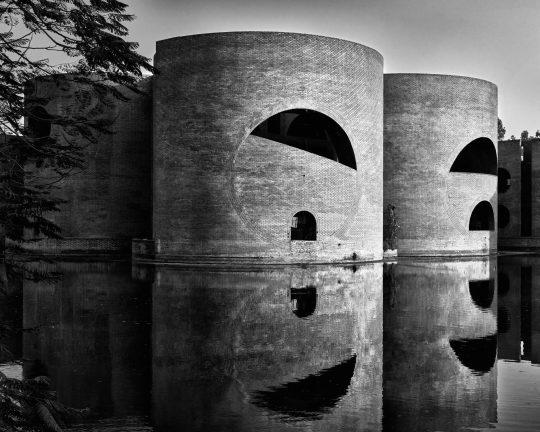
National Parliament Complex in Dhaka, Photo: Yes, Louis Kahn
SŠ: Transformation of Dhaka today is intensive. What would be some of the significant architectural achievements in contemporary Dhaka and Bangladesh?
Adnan Morshed: The architectural scene in Bangladesh has been thriving with a “new” energy over the past two decades or so. Bangladeshi architects have been experimenting with form, material, aesthetics, and, most importantly, the idea of how architecture relates to history, society, and the land. Their various experiments bring to the fore a collective feeling that something has been going on in this crowded South Asian country. One is not quite sure about what drives this restless energy! Is it the growing economy? The rise of a new middle class with deeper pockets? Is it an aesthetic expression of a society in transition? Is it aesthetics meeting the politics of development?
Whatever it is, an engaged observer may call this an open-ended search for some kind of “local” modernity. Bangladeshi architects have been winning architectural accolades from around the world for a variety of architectural projects. High-profile national architectural competitions have created a new type of design entrepreneurship, yielding intriguing edifices. Architects have also been expanding the notion of architectural practice by engaging with low-income communities and producing cost-effective shelters for the disenfranchised. Traditionally trained to design stand-alone buildings, architects seem increasingly concerned with the challenges of creating liveable cities.
No doubt it is an exciting time in Bangladesh, architecturally speaking, even if the roads in the country's big cities are paralysed by traffic congestion and a pervasive atmosphere of urban chaos. In the midst of infernal urbanisation across the country, an architectural culture has been taking roots with both promises and perils, introducing contentious debates about its origin, nature, and future.
Architecturally, the 1980s was an interesting time, as divergent ideas began to permeate architectural thinking in the country. Three stories should be mentioned. An “avant-garde” architectural study group named Chetona (meaning awareness) sought to introduce critical thinking as an essential part of architectural practice. Many architects, senior and junior— disillusioned with the prevalent role of architecture as primarily a professional practice without broader social visions and engagement with history and culture—gravitated toward Chetona, meeting at Muzharul Islam's architectural office, Bastukalabid, at Poribagh. The iconoclasm of the study group revolved around reading critical writings in architecture, criticism of current methods of architectural pedagogy, and reasoned questioning of architecture as a technical discipline. The group's reading list ranged from Rabindranath Tagore to the Franco-Swiss architect Le Corbusier to the Norwegian architectural theorist Christian Norberg-Schulz.
The influence of the Aga Khan Award for Architecture (AKAA), an architectural prize established by Aga Khan IV in 1977, was also felt strongly during the 1980s. The award sought to champion regional, place-based and culture-sensitive architectural impetuses in Islamic societies. Awardees included projects in contemporary design, social housing, community development, restoration, adaptive reuse, and landscape design. Architects were inspired to look for a “spirit of place.” Regionalism was in vogue.
The Aga Khan Award for Architecture's flagship magazine, Mimar: Architecture in Development, first published in 1981, influenced many Bangladeshi architects and architecture students in thinking beyond western modernism and the aesthetic conventions it allegedly created. At its inception, Mimar was the sole international architecture magazine focusing on architecture in the developing world. In many ways, the magazine's celebration of “local” expanded the scope of architectural practice in the country and gave rise to new aspirations among architects, who were willing to search for organic roots in architecture.
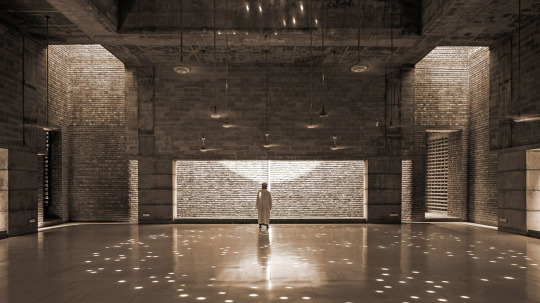
Bait Ur Rouf Mosque in Dhaka by Marina Tabassum, 2016 Aga Khan Award Recipient
The new architectural aspirations coincided with the rapid urbanisation of Bangladesh and the rise of an urban middle class that spawned a flourishing culture of architectural patronage. A historically agrarian country, Bangladesh began to urbanise rapidly from the late 1980s. The country's total urban population rose from a modest 7.7 percent in 1970 to 31.1 percent in 2010. Impoverished rural migrants began to flock to major cities, particularly the capital, Dhaka, in search of employment and better lives. Its population skyrocketed from 1.8 million in 1974 to more than 6 million in 1991 and to nearly 18 million today. The capital city's massive population boom created an unsustainable demand on urban land, and in return, land values increased.
During this transitional period, real estate developers emerged as powerful economic actors in Dhaka and beyond, playing a key role in replacing traditional single-family houses with multi-story apartment complexes. Meanwhile, public-sector housing failed to meet the demand, and in this vacuum, private real estate companies flourished rapidly. As private developers became key actors in the city's housing market, a trade association was needed to regulate the real estate sector and to ensure fair competition among its members. The stratospheric rise of private real-estate developers suggested that there was a robust market for high-density, multifamily apartments, even though affordability remained a major hurdle. Many architects experimented with material, form, spatial organisation, construction, aesthetic expression, and the individual plot's urban relationship to the neighbourhood.
A burgeoning class of urban entrepreneurs—who made their fortunes in the country's export-oriented ready-made garments industry, manufacturing and transportation sectors, construction industry, and consumer market—emerged as a new generation of architectural patrons, investing hefty amounts of money to build their signature single-family houses and other projects, including apartment complexes, hospitals, shopping malls, private schools and universities, factories, spaces of worship, etc.
And, happily, architects began to find work abundantly from the mid-1990s. Design consultancy until the early 1990s was limited to a handful of architectural firms. But soon thereafter new, smaller firms, run by younger architects, began to reshape the traditional methods of architectural design practice in the country.
The liberalisation of the market, the emergence of a strong private sector, and rapid urbanisation resulted in the need for a range of building typologies and related architectural design services. In the public sector, government organisations began to evaluate the social and commercial value of aesthetic expression and hired architectural firms to compete in the building market. All of these developments ushered in a vibrant and dynamic opportunity for architectural experiments. The last two decades in Bangladesh witnessed an intense battle of architectural ideas. The earlier attitudes to orthodox modernism or regionalism in architecture dispersed into a more nuanced landscape of aesthetic abstraction.
SŠ: „For most of modern history, cities grew out of wealth. Even in more recently developed countries, such as China and Korea, the flight towards cities has largely been in line with income growth. But recent decades have brought a global trend for “poor-country urbanisation”, in the words of Harvard University economist Edward Glaeser, with the proliferation of low-income megacities.“ Dhaka is an example of such a city that has outpaced develepoment and has grown tremendously. Can planned urbanisation even tackle such a huge task in given circumstaces?
Adnan Morshed: While architecture rose and prospered as individual plot-based or stand-alone practices, cities—Dhaka as a glaring example—as a whole descended into unbearable chaos. In extreme cases, Taj Mahals coexisted with overflowing dumpsters. Private oases and sumptuous cafes overlooked the ghettoised world of slums. While architects searched for Bengali roots and global gravitas in their work, they mostly failed to promote an “ethical” view of how city should function and treat all its citizens.
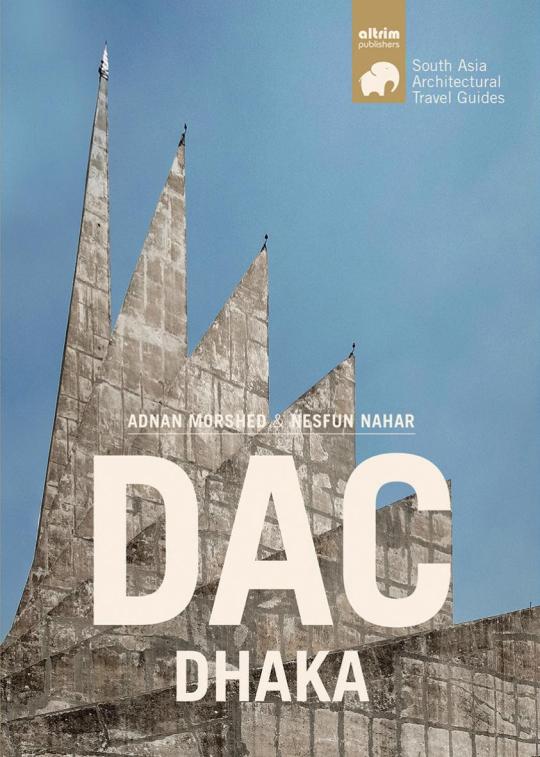
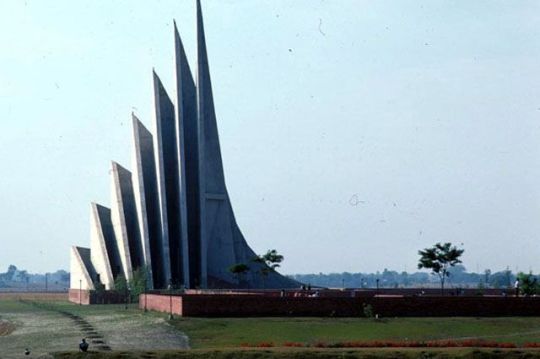
While globalisation went on with a cutthroat consumerist and neoliberal agenda, and architecture patronage benefitting from it, social inequality grew manifold. Architects seemed confused as to how architecture could or should also play mitigating roles in addressing the issues of social justice. Slums burned and architects rushed to the site with naïve, superficial aesthetic solutions without trying to understand the exploitative economic and political systems that blight society in the first place. The feeling that “architecture is great but the city rots” sometimes seems overwhelming.
Walking in some of Dhaka's walkable streets fronted with exclusive-looking buildings, an observer might wonder how architecture could showcase the rising stature of a developing country, while failing to play a role in making it socially just.
_
In Croatian: https://vizkultura.hr/intervju-adnan-morshed/
_
Projekt Motel Trogir u 2021. godini podržan je od Ministarstva kulture i medija Republike Hrvatske i Zaklade Kultura nova.


10 notes
·
View notes
Video
#bahria #NOTE..! BUY NOW MY SERVICES..! 🏠Get your House design today ⌚Best time to get your house design 🔥 #Hot #Offer: #Consultant (#BahriaTown #Lahore)(#Allahumdulillah ) #2dhouseplan #3dfrontelevation #Structuredesign #design #interior #interiordesign #art #love #homedecor #instagood #photography #architecture #instagram #decor #fashion #travel #interiorstyling #model (at Bahria town lahore ,islamabad,) https://www.instagram.com/p/CVGXKgPJ1fa/?utm_medium=tumblr
#bahria#note#hot#offer#consultant#bahriatown#lahore#allahumdulillah#2dhouseplan#3dfrontelevation#structuredesign#design#interior#interiordesign#art#love#homedecor#instagood#photography#architecture#instagram#decor#fashion#travel#interiorstyling#model
2 notes
·
View notes
Text
FOMA 37: Forgotten Greece
Forgotten Greece Masterpieces are obscure and understated, but still special in their own subtle way: it is the lack of fanfare, a certain restraint in the architecture that accentuates their genuine character, therefore they merit a closer look.
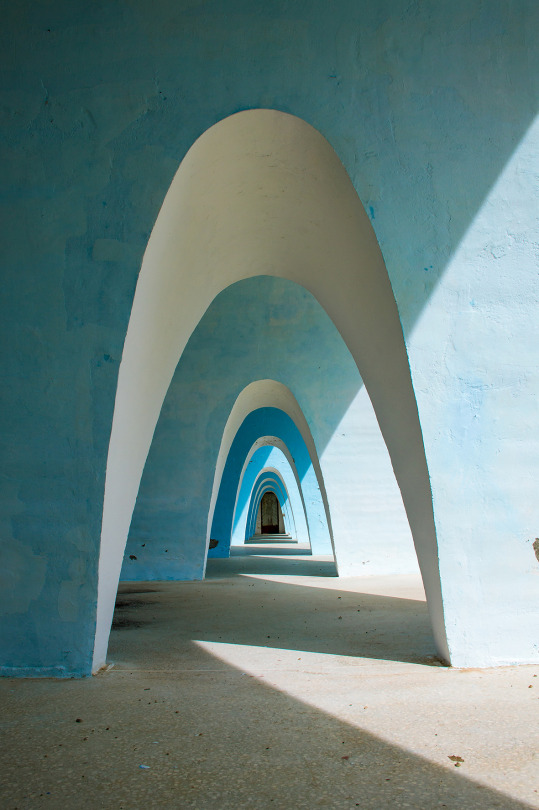
Concrete arches of Magoula Cemetery emanate an aura of Aalto’s wave designs or elements of Niemeyer’s Brasilia | Photo by Exporabilia
Each space comes with an interesting backstory and an evidence of how post-war ambition and civic pride fuses with classical tradition, science, folklore, religion and the natural environment. There is also an evidence of architectural brilliance mired in political persecution, indifference, schadenfreude or a lack of recognition by the establishment. Such storylines are as quintessentially Greek as drama and each might weave their unique pattern into the architecture.
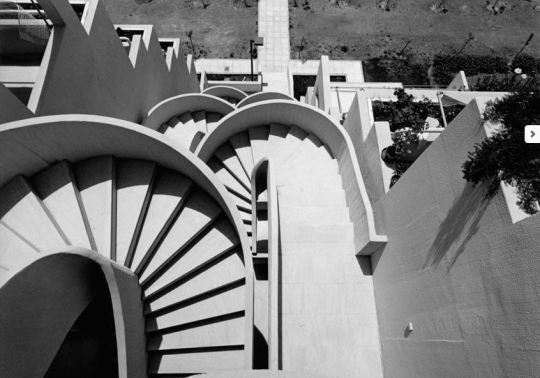
Aspra Spitia is a settlement to house employees of the Aluminum of Greece factory and mining operations west of Athens. | Photo via Fotiadis
Greeks demonstrated an innate affinity for siting and orientation since their temple building days of antiquity. Stillwell (1954) describes a mastery of form, angle, height and orientation: their temples were a planned succession of experiences that culminated into a grand, final approach of the cult image. Temple construction was an early use of architecture and urban planning principles to deliver a coherent visual and emotional result - exempli gratiaa transcendental, religious experience.
youtube
In post-war Greece, architect and urban planner Constantinos Doxiadis drew inspiration from the same fountain of knowledge. He created a seminal worker���s settlement that both transcended the provincial vernacular andchimed in fascinating consonance with its natural surroundings. It is like a place of eternal youth by design like Logan’s Run Caroussel), where residents never get to grow too old.
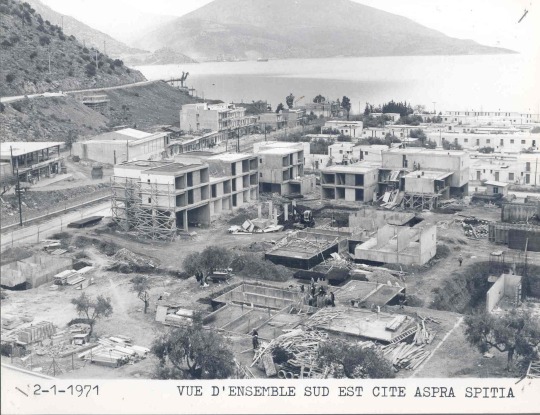
The construction phase on of Aspra Spitia. | Photo via © Doxiadis

Through Ekistics, Doxiadis approached settlements as complex biological organisms. | Photo via Voiotias
Aluminum of Greece was launched in 1960 as a joint venture between the government of Greece and an industrial conglomerate led by the historic French firm Pechiney, a world leader in aluminum manufacturing. As a result, the first aluminum production facility in the country opened on the northern coast of the Corinthian Gulf in 1966. Capitalising on the nearby bauxite ore mines (one of the largest deposits in Europe), the vertically integrated manufacturing process ranged from raw material extraction to the delivery of a range of secondary bauxite and aluminium by-products. It was an ambitious and successful industrial project that created new opportunities for employment for those prepared to settle there. The sheer scale of the industrial unit and its ancillary facilities, however, created an urgent need for housing the employees, prompting the creation of a new settlement nearby. They called it Aspra Spitia (White Houses), and to this day, it remains a model for small scale urban planning with a unique blend of Modernist yet distinctively traditional Greek aura.

Constantinos Doxiadis in 1975
The urban planning, layout and design of the settlement was masterminded by Constantinos Doxiadis and his associates, who also delivered the first phase of the project. Doxiadis, an experienced urban planner who held various Public Works related government posts for the Greek government between 1937 and 1951, was a leading figure in the country’s post-war reconstruction effort. His private practice has been rising in international prominence since it was founded in the early 1950s; by 1959, he was appointed as chief urban planner for the city of Islamabad, Pakistan, while his firm was involved in numerous local and international projects, prompting him to construct a new headquarters in Athens to house their now 400 strong team of urban planners, architects, and engineers.
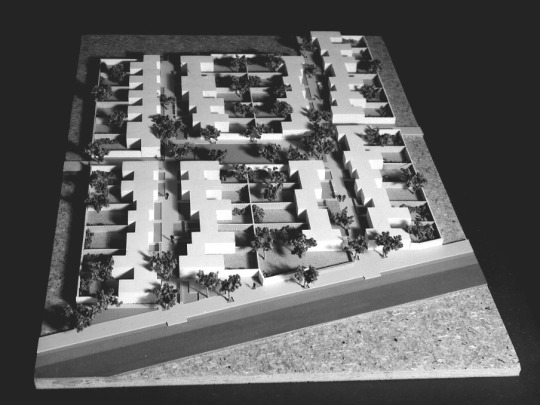
The model for Aspra Spitia. | Photo via © Doxiadis.org
Still, Aspra Spitia was a challenging brief: there was nothing but olive trees and a few vernacular shacks inside the tiny seaside valley. The first wave of French engineers settling at the newfound community were disheartened: this rugged slice of paradise had yet little to show in the way of creature comforts. And there was a looming danger in choosing to deliver a typical, prefab industrial settlement, with identikit housing units built around amenities: that choice of plan was expected to mark the marvellous landscape irreparably, presenting an unsuitable urban continuation of the industrial landscape at the nearby factories and mines. The new resident workers might feel disconnected, transient, and without a sense of belonging to the very habitat they might end up spending their entire career.
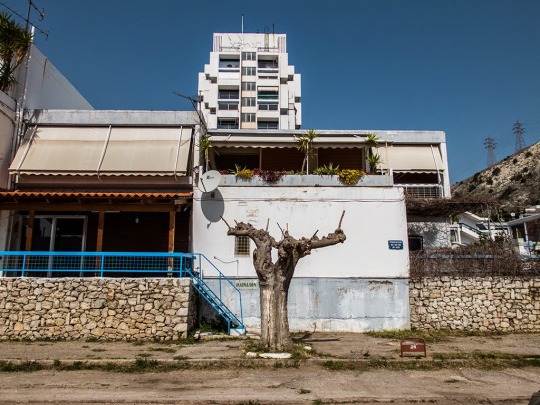

A commercial centre Tower | Photo via © astronayths.blogspot.com
However, Doxiadis had a clear vision about Aspra Spitia. His plan was informed by his Ekistics philosophy, first proposed in 1942 and constantly developed since. Through Ekistics, Doxiadis approached human settlements as complex biological organisms - capable of forming connections with each other, constantly evolving, merging and scaling in orderly harmony with the natural environment. And preserving the purity and beauty of the hills, the seafront, and the olive tree fields within the planning scope of a factory, mines and a worker’s settlement at Aspra Spitia became a key challenge. These very different, both natural and man-made constituent units demanded to be re-shaped into a natural fit. This wouldn’t be about forcing an irreverent, modern smudge in the landscape: it’d be about the foundation of an orderly, organic urban environment.

A corner unit of the Phase 1. | Photo via © astronayths.blogspot.com
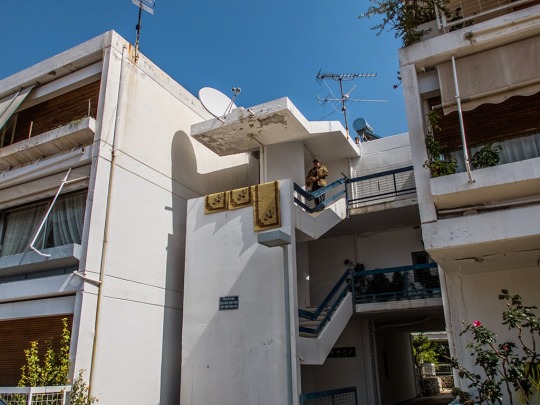
Stairs from the Phase 2. | Photo via © astronayths.blogspot.com

Units from the Phase 2. | Photo via © astronayths.blogspot.com
Thankfully, Doxiadis’ Ekistics already proposed such a scalable hierarchy for ordering urban settlements – an arrangement that social and biological sciences concluded was important for the avoidance of chaos. And at the beginning of the scale, there was Anthropos – the individual. It was expected that the aluminium workers would be mostly recruited from the nearby rural areas. Therefore, understanding the familiar traditions those new settlers were expected to carry with them was a crucial design element, as well as preserving the individuality of each constituent unit: each house, each cluster, each neighbourhood had to feel fresh and special, but still flow with identifiable tradition and heritage, also retaining a degree of deference to the natural environment. And the whole ensemble needed to remain functional for its intended purpose, without reverting to picturesque anachronisms.
All these elements were carefully infused into the inverse L-shaped city plan, which follows the organic contour of the landscape closely: The long leg is flanked by hills, while the short leg is laid across the seafront. Within the resulting space, four neighbourhoods were created, each circled by a peripheral road. The civic, business and administrative forum of the city is located at the junction of the legs, while a recreation and tourism area is laid along the seafront.
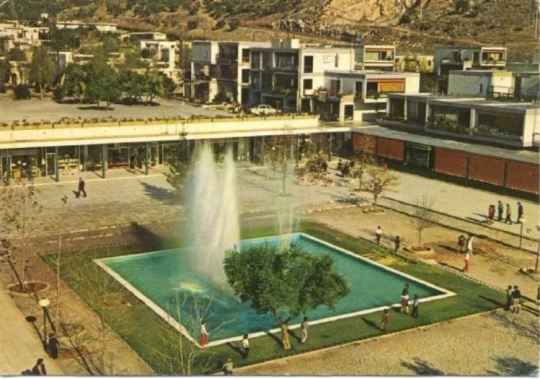
The settlement’s main square.
The design of the residences and public spaces is where it all comes together. Twelve unique house designs were utilized, each standardized with interchangeable elements that enabled the architects to alter the design in intermediate stages of construction. This technique increased the resulting variety of house types to twenty-five, while further variations were achieved by mixing-up the properties of each street in terms of house orientation, elevation, set back, and corner placement. Therefore, each home and each neighborhood look unique, but also retains a thematic familiarity with the whole ensemble of the town.
Both natural and modern materials are utilized, concrete, wood and local stone. The walls and stone are mostly whitewashed, offering a traditional Greek visual clarity to the settlement. Some stone walls remained natural with intent, in cases where these blended visually with the surrounding olive groves. The preservation and integration of existing olive trees in squares, yards and street layouts was prioritised, and supplemented by re-planting as well as new plantings. Stone fences, pergolas, steps and pavements complete the textured landscaping of each neighborhood, while well placed cul-de-sacs, squares and public thoroughfares complete the harmonious balance of private and public spaces.

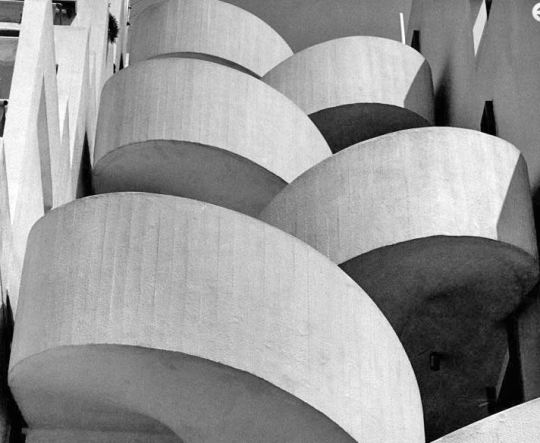
Stairs from the Phase 3. | Photo via © Photiadis.gr
Aspra Spitia was completed in three phases, and now boasts 1072 residences housing approximately 3.000 residents. After the completion of the first houses and amenities by Doxiadis Associates, the city expanded both vertically and aesthetically with additions by C.Lembessis, P.Massouridis and M. Photiadis. A series of high rise, larger apartment blocks as well as specific amenities for the individual needs of the workers and the families were erected. These include a business centre, a nursery, and even a Catholic church for servicing the religious needs of the French settlers. One of the most ground breaking amenities was the installation of a sewage water treatment plant, which was the first of its kind in Greece at the time.

A series of specific amenities for the individual needs of the workers and the families were erected, like the nursery. | Photo via © Photiadis.gr
In terms of administration, Aspra Spitia is not far from the purpose-built, model socialist towns of the former Eastern Block. The settlement belongs to Aluminium of Greece (AL), and working in the mines or factories is a prerequisite for obtaining a house or a flat. A point system exists to help fulfil housing needs accurately, allocating the right type of property per household size. Residents are only required to pay a token monthly rent, while all property maintenance and upkeep is handled by the company. Naturally, these privileges last only for the duration of employment. Workers who wish to move on to another company or reach retirement age aren’t eligible to stay anymore: they are required to vacate their house, after making all necessary alternative arrangements. This is a town where people are not expected to grow old, and the reason why a cemetery was never planned as part of the urban grid (the nearest ones can be found in surrounding villages).
If Ekistics is about approaching urban environments in biological terms, then Aspra Spitia possibly holds the secret for urban immortality: free from the mortal vestiges of permanence and ownership, this is a model town that is, and will remain as fresh and tidy as planned over half a century ago.

The Church. | Photo via © astronayths.blogspot.com
The next stop is a few miles across the water from Aspra Spitia, where a forgotten Isthmia Prime Motel presents an abstract expression of three Classical disciplines: architecture, mathematics and music.
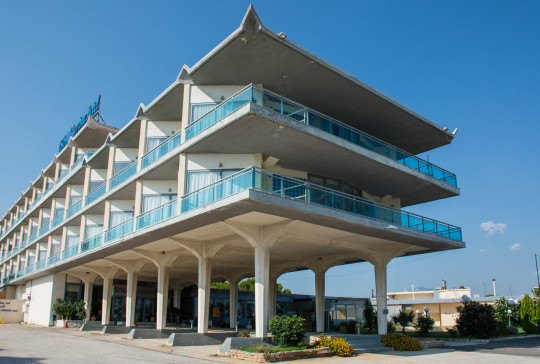

The unassuming roadside motel by the Isthmus of Corinth is an intriguing cross between Brutalism and the Classical Orders. | Photo by © Exporabilia
In its heyday, the main motorway linking the greater metropolitan area of Athens to the city of Corinth in the south west was one of the busiest arteries in Greece's road network. Built between 1960 and 1969, the motorway would hug the craggy cliffs outside the capital with its narrow ledge, offering breath-taking, and somewhat dangerous views of the sea below. Vehicles would naturally slow down at the Isthmus of Corinth, the canal that allowed shipping to navigate the strip of land connecting the Peloponnese to Attica. The slow crossing of the Isthmus Bridge enabled passengers to admire the view of the man-made chasm below, and traditionally led to a quick pit stop on the other side of the canal.
The Isthmus region was becoming a very popular weekend escape with Athenians post war. At about one hour drive from the capital, it was near, yet far enough to enjoy the sea and fresh air. Small villas and seaside hotels sprang out in local villages and hamlets for weekenders to escape the hustle and bustle of a rapidly urbanizing Athens.
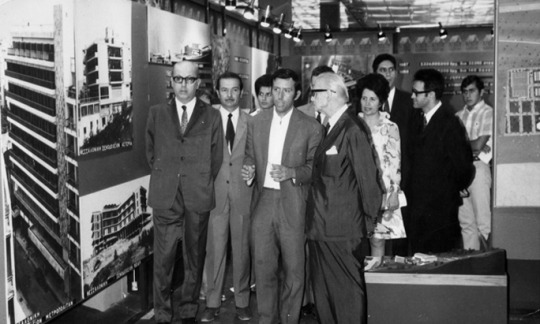

Panos Spiliotakos presenting his work. | Photo via © ema-arch.com
It is at this popular stopover area past the canal, where the strangely alluring hotel was built in 1969 in a collaboration between composer Iannis Xenakis and urban planner Panos Spiliotakos, two visionary friends expressing their common architectural heritage.


Iannis Xenakis | Photo via © Adelmann Collection of Françoise Xenakis
Xenakis was perhaps the most well-known of the duo. He was a Greek multidisciplinary artist with a passion for music and engineering and an unquestionable aptitude in both. He survived the war suffering a terrible face wound - caused by shrapnel from a shell fired by a British tank into a crowd of Communist protesters demonstrating in the streets of Athens in December 1944. As a qualified engineer, he left for Paris in 1947 where he worked under Le Corbusier at the Unite D'Habitation and Convent De La Tourette.
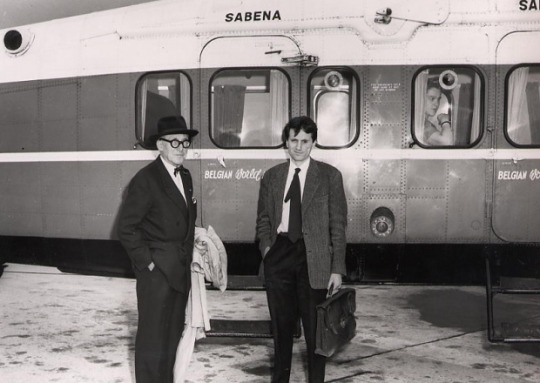
Le Corbusier with Iannis Xenakis. | Photo © Iannis Xenakis
During that period, and through his own musical culture, Xenakis soon realised that the same complex spatial geometrical patterns applied in Le Corbusier's architecture - the structural calculations, the intersecting tones and curves - could be applied to the composition of music too. His seminal 1955 musical work Metastaseis (lit.transmutations) was inspired by Einsteinian ideas about time and space, and utilised the mathematical principles of the Fibonacci sequence and the Golden Section structured around Le Corbusier's architectural calculations. It shocked the world of contemporary music at the time: this was original Brutalist music, with all the sonic cantilevers, rebar and board marking you could handle.
youtube

The Algorithmic Compositions of Metastaseis
Xenakis' knowledge of architecture allowed him to use graphic notation to represent his music. The string glissandi and other musical motions of his piece, representing sonic beams with time on one axis and pitch on another, looked less like sheet music, and more like a blueprint. With Le Corbusier occupied in the construction of Chandigarh in India, Xenakis went on to design the Phillips Pavilion in Brussels Expo 58 on his behalf. It's a unique marriage of music and architecture, with its hyperbolic paraboloid masses deriving from the musical landscape of his own Metastaseis.
Inside the Pavilion, an expansive array of speakers and dials were arranged in an acousmonium: an avant-garde playback device used to spatialize musical scores. The array had been invented in the 1940s by proponents of musique concrète, an experimental circle of composers with whom Xenakis was associated. Further musical scores by Xenakis and Edgard Varese were performed this way throughout the pavilion, creating a unique meta-experience that fused architecture and music like never before.

The Phillips Pavilion in Brussels Expo 1958. | Photo © Wouter Hagens
True to the genius of Iannis Xenakis, the building by the Corinthian Isthmus emanates a classical aura throughout. Built as a modern diversorium (a roadside inn), it reflects the long Graeco-Roman resort heritage of the area. The sulphur baths at nearby Thermae (today's Loutraki) attracted visitors since the antiquity. Many classical villas and baths have been discovered in the region through the years. It makes perfect sense that Isthmia Prime's characteristic main entrance colonnade is made of 12 stern, board-marked concrete columns, a Modernist throwback to the Doric order of the nearby Temple of Apollo. The colonnade is supporting the 3-storey main residential block, with the rooms arranged obliquely to the main axis to maximise the beautiful views of the Gulf of Corinth beyond.

The colonnade is supporting the 3-storey main residential block, with the rooms arranged obliquely to the main axis. | Photo by Exporabilia
The triangular concrete antefixeson the flat roof is another wink to the floral anthemiaof antiquity, the decorative palmettes that adorned the eaves of ancient Greek and Roman buildings. The block is intersected by the reception and services area at ground level, allowing for a practical green area at the front with a star shaped pond. Iannis Xenakis reminded us that rhythm, as symmetrical repetition, is the ancient, supernatural bond that links mathematics, music and architecture. Isthmia Prime is an elegant, if somewhat forgotten example of these classical and artistic traditions, fused expertly together with his characteristic elan.
The building at Corinth is a Modernist throwback to certain familiar artistic traditions of Classical antiquity. At the corollary of this Athenian-centric luminary ethos, there’s a counterpart a Spartan-centric ethos, founded on the principle of selfless sacrifice as the pinnacle of civic achievement. Naturally, there’s less opportunity to go down fighting under a hail of arrows in our day. But dedicating one’s life in the service of the state is here presented as a visual metaphor of Sparta’s finest traditions in the Modernist Necropolis of Magoula.

The waveform of the Magoula Cemetery is symbolic of the up's and downs we go through life. | Photo by Exporabilia
The new city of Sparta was founded in 1834 at the behest of Otto, the Bavarian prince who became the first King of Greece in the aftermath of the nation’s successful war of independence. He embarked on a revivalist program that aimed to modernize and urbanize Greek towns. The project was led by Eduard Schaubert,a Prussian architect and topographer who studied under Karl Friedrich Schinkel in Berlin’s Bauakademie. Schaubert also re-designed Athens, Pireaus and other major Greek cities, finely tuning their plethora of Classical and Byzantine sites with the Neoclassical neighborhoods, squares, and administrative buildings that typified the Greek national revival. This is how Sparta, previously obliterated by the Goths in the 4thcentury, was restored by royal decree in 1837. The re-established Sparta became, in fact, the first of the new Greek towns whose design was based on an actual urban plan – thus breaking with the disorderly, vernacular yoke of medieval urban spaces.
A century later, Sparta remained a quaint agricultural town, virtually unchanged since Schaubert planned it. The beautiful neoclassical facades were crumbling, and the street grid had deteriorated and was unsuitable for the ever-increasing motor vehicle traffic. The sewage system was old, and problematic. What’s more, modern Sparta was a city with a distinctive lack of modern facilities and monuments – it was becoming lethargic, almost as if the Goths had somehow travelled forward in time, sacking it again into oblivion.

There are entrances to either end of the arches, one leading to a small functions area, and another to the ossuary. | Photo by Exporabilia
The man who changed all that was Georgios Sainopoulos, the philanthropist who became mayor of Sparta for two terms, over a period of 8 years between 1964 and 1978 (interrupted by the Colonels’ Junta, who ousted him between 1967 and 1974). Sainopoulos dedicated his life to the improvement of urban life in Sparta, delivering numerous projects related to sport and cultural facilities, new road & water network infrastructure, and monumental public art. The 1964 cemetery at the satellite hamlet of Magoula was created at his behest - this was his birthplace, and where he seemed to make an almost personal statement about his intention to take the city out of its enduring quagmire, and into an era of progress. The cemetery, alongside other luminary philanthropic projects, was realised via donations he secured from close relatives Ioannis and Catherine Sainopoulos, Greek emigres based in Oklahoma, USA. He then invited local architects Charilaos and Sophia Polychronopoulos to deliver his vision of a surprising modern necropolis that exceeded conventional expectations.

Windows reflect the bright Peloponnesian sunshine in the colors of the CIAM grid green, red, yellow and blue, creating a kaleidoscope of colours inside the space where the funerary chests are kept. | Photo by Exporabilia
Sainopoulos might have been informed by his own experience of monumental modernism as a visitor during the Olympic games of Helsinki in 1952. It would have been an inspirational showcase of Nordic Modernism, exemplifying Olympic ideals, and much of it can still be admired to this day. The waveform these arches form at Magoula is said to be symbolic of the ups and downs we experience throughout life. There are entrances to either end of the arches: one leading to a small functions area, and another to the ossuary, both decorated with saints and religious figures made out of bent rebar. The windows reflect the bright Peloponnesian sunshine in the colours of the CIAM grid: green, red, yellow and blue, creating a kaleidoscope of colors inside the space where the funerary chests are kept.
Ancient Spartan traditions exemplified order and simplicity in all aspects of life, which often carried into funerary rites. Spartans were buried among the living, in anonymous graves inside the city walls. Only those fallen in battle, or women dying in childbirth were deemed important enough to merit their names on gravestones, typically lined up along busy thoroughfares & promenades – therefore transforming their tombs into public monuments. Further inside the Magoula cemetery proper, it is evident that several graves have been created in deviation to the unremarkable, marble-clad basilica orthodoxy of Greek cemeteries: the scale, shapes and materials are different, and there are statues, busts, carvings and funerary symbols that simultaneously reflect a sense of civic grandeur, and a closer affinity to the Western European funerary canon.

Shapes and materials of graves are different, statues and symbols reflect a closer affinity to European funerary traditions. | Photo by Exporabilia
Leonidas, the famous king who fell in Thermopylae was perhaps the most well-known son of Sparta. It is said that his remains were posthumously transferred to Sparta and deposited at Leonideon, a rectangular tomb close to the agora that can still be seen today. And as opposed to the more modern, extra muros Roman burial traditions, there’s consequence in the way that the tombs of all true citizens become very much a part of the living urban space. But especially the tombs of those who, like Leonidas, contributed significantly more to perpetuate the lore of their communities, become monuments of civic pride, and public remembrance. Uniquely, Sainopoulos' own resting place is a sizeable vault, accessible through a flight of steps near the entrance to the cemetery. It is a feature rarely - if ever - seen in contemporary Greek cemeteries, and underlines the important character of the site’s mastermind. Arguably, this space represents a somewhat obscure link between the principled simplicity of the Spartans and the visual clarity of Modernist architecture. Deciphered in the key of the region’s Spartan heritage, the beautiful ensemble at the cemetery of Magoula is so much more than the average burial site usually seen in Greek towns : it is a poignant memorial showcase of lives well lived in the service of the local community, beautifully conveyed through the avant-garde architectural mind set of the 1960s.

An eclectic, monumental ensemble that fuses Classical, Byzantine and Romantic architectural styles. | Photo © M. Hulot
The civic principles of the Hellenistic world eventually clashed with the tenets of Christianity. In Greece this tectonic collision created new philosophical and artistic planes that inadvertently radiated their common roots, despite the necessities of doctrinal contrasts. Understanding this blend is quintessential to understanding the modern Greek psyche. The temple of Agia Foteini of Mantineia is the ideal visual representation for this melding process.
In the sunlit Arcadian plain close to the ancient city of Mantineia, there’s a church like no other. It’s an astonishing melange of styles, combining elements of Classical, Byzantine and Modern architecture, and yet remaining true to none. Its construction is the life’s work of architect and iconographer Kostas who has delivered an epic display of drama, faith and devotion that has astonished and divided ever since.
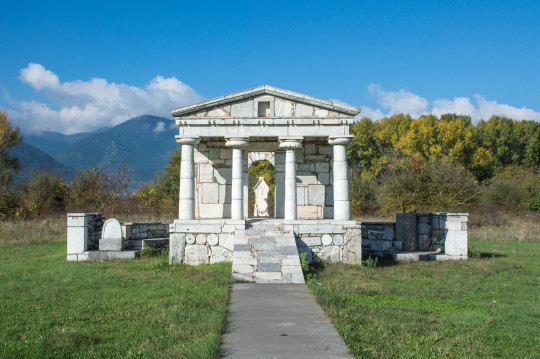
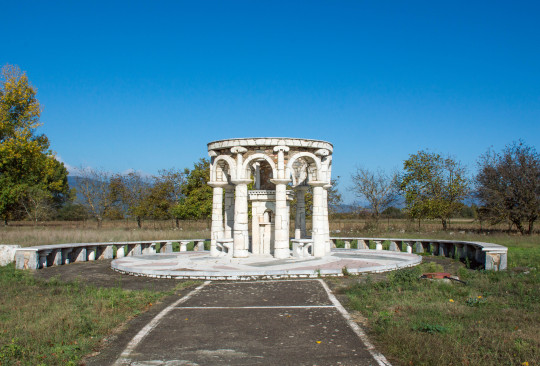
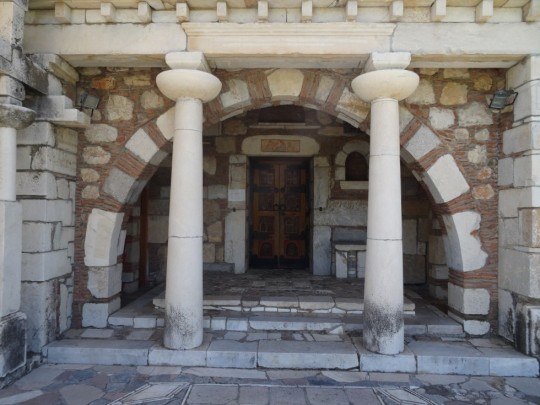
Heroic Tomb, Jacob’s Well and the Church’s Entrance. | Photo © M. Hulot
Papatheodorou was exposed to gothic religious architecture, particularly influenced by Erwin Von Steinbach's work in Strassbourg Cathedral. After his studies he returned to Greece in 1967, where he worked for the Ministry of Culture, studying further under the architect Dimitris Pikionis. During his tenure there, he was exposed to the idea of building a monumental church on behalf of the Mantineian Association, a cultural group dedicated to the preservation of the antiquities of Ancient Mantineia in the southern region of Peloponnese. Bewildered by the beautiful scenery, the majesty of the ancient site, and the character of local customs, he proposed the design of an extraordinary building that captured the region’s quintessence: a visual link among the Classical, Byzantine and Modern traditions of Arcadia.

A mosaic inside the church. | Photo © M. Hulot
He resigned his public service role in 1970 to dedicate himself to the project, which eventually became a lifelong commitment. No formal contract was drawn, funding was scarce, mostly based on charity grants and donations from locals and members of the Mantineian Association. Driven by an almost divine inspiration, Papatheodorou moved on location, living in a tent pitched next to the site. This way, he could absorb the spirit of the locality, and focus on the formative stages of the project unhindered. He was often seen roaming construction sites and recycling centres in nearby towns, gathering reject materials: cornerstones from demolished townhouses, leftover marble slab fragments, or broken clay tiles from old roofs. He worked mostly alone, collecting, measuring, chiselling the materials, shaping and piecing the fragments together into an astonishing monument that soon began taking shape. His only help was unskilled manual labour provided by local farmhands. The Classical and Byzantine parts and techniques merge into one another on the walls and bell towers of the church, creating a visual disruption that expresses the forward motion of history - as one era blends into another, leaving its indelible mark at the seams of history. The church becomes a visual representation of the area’s disparate yet interlinked memories, converging through the aeons to create a homogeneous body of local culture.
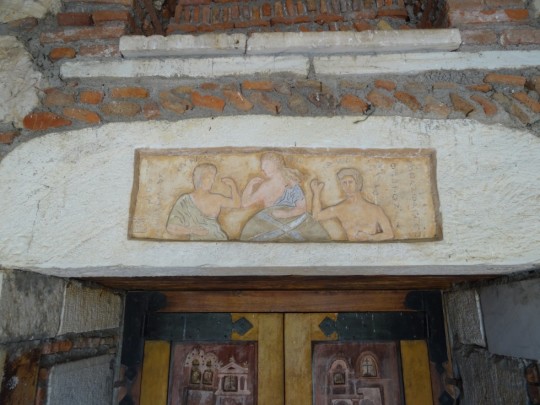
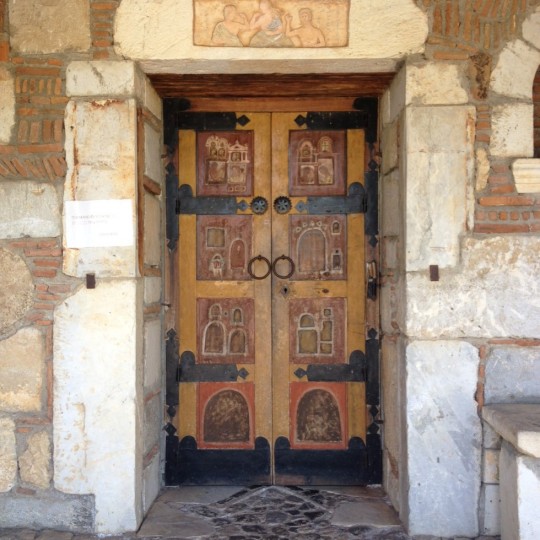
The main entrance. | Photo © M. Hulot
The main structure was completed by 1974, then the interior work began. Inside the church, we see the expression of the architect as an iconographer: The concept of stylistic variety continues, with sequences of religious and pagan themes combining on the mosaics and wall paintings. Classical symbolism such as meanders, pastoral or hunting scenes abound, and figures in ancient togas blend with Christian saints dressed in modern attire, such as jeans and t-shirts. It was too much for a portion of local clergy, who began raising eyebrows: certain offending visuals are then amended to avert the church being characterised as inappropriate for consecration. Conservative circles begin to gossip Papatheodorou, accusing him of irreverence and idolatry. Some others allege that he has unlawfully appropriated materials from the ruined temples and shrines of Ancient Mantineia to incorporate in his church.
But those who recognized and appreciated his work also lend their support – architects, archaeologists and art curators underlines the multidisciplinary reach of his work. The famous Greek painter Yiannis Tsarouchis described the church vividly as fresh water for those in thirst: “When I saw the church, I felt the elation one feels when a justified complaint is suppressed. I’ve heard people characterise Kostas Papatheodorou as an “aping architect”. What I found at the church, however, was a genuine heartbreak, a desperate confession. In our age of fake moralism and ludicrous rationalism, these rare qualities become as important as a vein of fresh water during drought”
The next few years saw the construction of two ancillary buildings, a miniature Classical shrine dedicated to local war heroes, and a fountain with a circular colonnade, representing the biblical fable of Jacob’s Well. The Church is considered work in progress to this day. Some contemporary critics stated that the Church of Agia Foteini of Mantineia is the Greek Sagrada Familia. This may be a somewhat flattering, even inflammatory characterisation for some. There are parallels, however, between the work of Antonio Gaudi and Kostas Papatheodorou as both churches are considered incomplete, both architects deployed their proficiency in a number of related disciplines, incorporating these in their design - ceramics and wrought ironwork for Gaudi, it’s iconography and mosaics for Papatheodorou. Gaudi pioneered the use of trencadís, his famous mosaics made of reject materials, broken tiles, shards of glass, china or shells. Papatheodorou employed a similar technique by fashioning reject materials - such as stones and tiles - as found into walls, towers and mosaics. Last, both architects are inspired by Gothic religious architecture, and they are driven and inspired by their faith, which leads them to wholly devote their lives in their work. Agia Foteini of Mantineia might not have the scale or monumental appeal of the Sagrada Familia. It is however an equally unique spiritual monument, and an important symbol of the historic, cultural and religious ties that bind the people of Arcadia together.

Conceptual Scale Model of the Round School. | Photo © leximata
The resurgent Greek culture of the 19th century was inspired by the glow of its classical heritage, yet emerged fatefully disconnected from it. The impetus with which Greeks used to strive to make sense of what constitutes justice, of what makes an ideal community, or what is good governance - all philosophical questions explored in Plato’s Republic - had become secondary to the medieval moral and civic conventions of the late Byzantine era, and its disastrous outcomes. By the 20th century, a Neo-Hellenic culture has taken hold, characterised by romantic reminiscence, counterproductive self-pity, blind revanchism, and endemic corruption. Inside this purgatory, a vicious circle of astonishing success is always followed by stupefying failure, in an unplanned state of permanent complacency that is always attributed to certain fantastical others. It is a moral decline that Constantine Cavafis alluded to in his poem “Waiting for the Barbarians”, and is without doubt the starting point of the country’s recent string of financial and political failures.
Breaking this craven mould, Takis Zenetos was the Greek modernist architect who demonstrated unbridled optimism and progressive vision through his work. He has a rightful place in my obscure pantheon, another important 20th century personality that epitomized the virtue of living up to one’s own high standards of moral and civic duty.
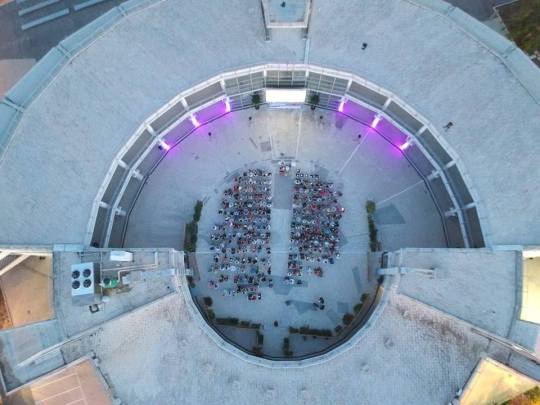
Round School top down view. | Photo © Dimitris Vosios
Agios Dimitrios (often referred to with its pre-1928 name, Brahami) is one of the most densely populated suburbs of Athens with a density comparable to Cairo or Seoul. The typical expedience and maladministration that characterized post-war Greece has left its indelible mark in the suburb’s architecture: its arbitrarily arranged streets define pocket upon pocket of unimaginative apartment blocks that connect to those of surrounding suburbs to form a veritable sea of concrete and tarmac. This is the result of the “flats for land” legislation of 1929, which enabled owners to give up their neoclassical houses in return for a flat or two in the uninspiring concrete tenements and high rises that soon began to blot out the quaint early 20c. suburban landscape. The desperate measure was initially brought in to manage the pressing housing needs of destitute immigrants from Asia Minor in the 1920s and 1930s. The 1.6 million displaced were joining a country of 5 million. This summary convenience was extended to solve later rapid urbanisation problems, such as the Axis occupation and its aftermath. Throughout the 1940s and 1950s, people fled the Civil War and the prospect of a hard life in their devastated villages and sought a better future in the capital, whose extant high density infrastructure had been equally ruined in a month of tenacious urban confrontation between Communist guerrillas and Government forces (the Decembriana of 1944).
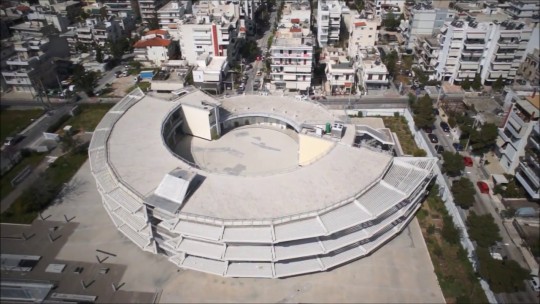
The new architecture principle is educational autonomy, its curves disrupt the sea of high rise blocks that surround it. | Photo © Thomas Andreopoulos
This short term, anarchic character of Greece’s urban planning mentality was deeply troubling for Takis Zenetos. Born and active in Athens for most of his life, he must have witnessed the entire devastating process first-hand: the consequence of conflict in the capital’s urban grid, coupled with the inexcusable sloppiness of the state managing it. The occupation interrupted his studies at the National Technical University (the Metsovion), but in 1945 he moved to Paris to continue at the Ecole Des Beaux Arts under Otello Zavaroni. He was influenced by the order and principles of Modernist architecture in France, before coming back to Athens to practice in 1955. For the next decade, Zenetos designed and built sensational, distinctively Modernist factories, apartment blocks and private villas, always in partnership with his friend Margaritis Apostolidis.
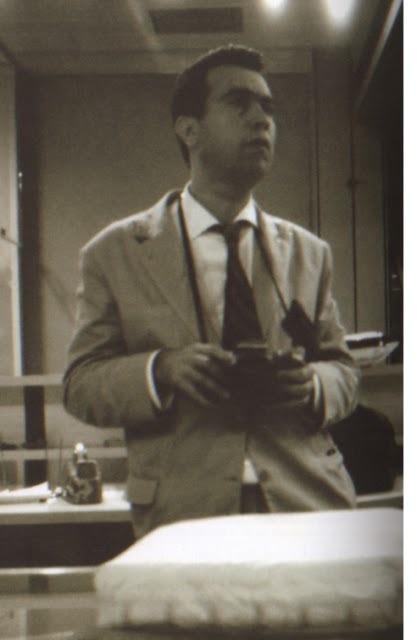
In 1962, Zenetos presented his theoretical concept of Electronic Urbanism founded upon his understanding that science and technology will revolutionize human living. He imagined the new social interaction and communication protocols of the future world; his ideas describe, in principle, what we know today as email, video calling and cloud sharing. His faith in the catalytic influence these would have in our daily lives was well ahead of its time, and informed his architectural designs. His “Furniture 2000”, a multimedia lounge chair for controlling the connected household of the future won a honorable mention in at the Interdesign 2000 competition in 1967.


Furniture 2000 | Photo via Tomorrows project
Zenetos envisaged futuristic networked cities, evolving around frameworks of massive, flexible cables. These web-like networks would solve the problem of urban regeneration once and for all, allowing the constituent components of the urban landscape - such as buildings, services, or amenities - to attach and detach, becoming replaceable parts of a whole that would easily adapt to the flow of an evolution driven by technology. At the same time, the natural environment would remain at ground level, unaffected. It would have been a landscape pure from infrastructure, with high-tech cities literally hanging from the skies.

Takis Zenetos The Hanging Hotel (1967). | Photo via Mascontext
We can take a glimpse at this unconventional approach, the capacity to innovate, his desire to disrupt the grim post-war urban architecture of Athens at the Round School of Agios Dimitrios. The Modernist rotunda is perhaps his most ambitious surviving work, and the one that still remains closest to his vision – since many of the private residences and factories he designed have either been demolished by municipal authorities on a whim and without consultation, or significantly altered. The reason the school survives mostly unaltered can be credited to the way Zenetos infused the built structure with his vision.
But there’s also a visual message. A new language emerges in the refined way the Round School’s Modernist curves disrupt the sea of high-rise blocks that surround it. This is an empowering environment of uniqueness and self-determination, and an anti-hierarchical symbolism designed to unclutter the young minds from the institutional architectural cues they are confronted by in educational spaces. It’s a bastion against the inner-city uniformity of Agios Dimitrios, of any Greek town. By raising the bar well above the Ministry of Education’s typology of schoolhouse ergonomics, Zenetos created an outstanding building that facilitates communication with its occupants, and a space that attunes them to the concept of individuality. His message hasn’t been lost to many generations of students, many of whom still reminisce of their journey in learning at the Round School with feelings of immense pride and appreciation.


The Round School is a personal statement, a defiant stand against an overwhelming standard of mediocrity. | Photo © Thano Baf
There’s no other Greek school like it, either before, or after this veritable piece de resistance. It is different, inspiring, a beautiful affront to an entire country’s post-war urban architecture manual. It is the product of a vision lost, but not entirely forgotten. Zenetos grew increasingly alienated by the lack of appreciation for his futuristic vision by the establishment. Frustrated by his inability to influence the change he believed in with all his heart, he took his own life in 1977.
—
#FOMA 37: Evan Panagopoulos

Evan Panagopoulos is the urban storyteller behind alternative site Explorabilia. He’s an avid fan of Brutalist and Mid-century architecture, likes engaging with abandoned spaces and obscure history, and expresses what he’s passionate about through writing and photography. His Forgotten Greece tour is available to book on Airbnb and Atlas Obscura.
97 notes
·
View notes
Text
Pakistan Naval Farms Islamabad

Pakistan Naval Farms Islamabad stands as a luxurious housing venture located in a prime area of Islamabad near Bara Kahu and Simly Dam. This upscale project is a collaboration between the Pakistan Navy and NHS Hometown Builders, offering an extensive range of farmhouse plots spanning from 5 kanal to 20 kanal. Nestled amidst Islamabad's picturesque scenery, it provides a unique opportunity for luxury living in a serene and natural environment.
Developer of Naval Farms Islamabad
PN Farms represents a collaborative effort between the Pakistan Navy, serving as the land provider, and NHS Builders, the esteemed developer. It epitomizes a perfect blend of upscale amenities and a harmonious natural lifestyle. Investing in this venture is deemed secure and reliable due to its oversight by the Pakistan Navy, ensuring the safeguarding of investors' interests.
Naval Farms Islamabad NOC:
Pakistan Naval Farms is a fully compliant and legally approved housing project, having obtained the necessary No Objection Certificate (NOC) from the Capital Development Authority (CDA) granted for 2343.26 Kanal on March 13, 1993. The sanctioned development area covers Phase 1, also referred to as A Block, which encompasses a curated collection of farmhouses ranging from 10 kanal to 20 kanal and beyond. Furthermore, Phase 2 and the Extension, inclusive of Blocks B, C, D, and E, are designed to offer smaller farmhouse plots, catering to a varied spectrum of requirements and preferences.
Pakistan Naval Farms Location:
Pakistan Naval Farms is strategically situated in Mouza Pind Bhegwal, Mera Bhegwal, and Athal within Islamabad Zone 4, making it an ideal location. It is near Park View City Islamabad and Bahria Enclave Islamabad, offering convenience and accessibility. Accessing Pakistan Naval Farms is straightforward, as it is conveniently reachable via Malot Road, which connects from Kurri Road through Park Road and Simly Dam Road. Furthermore, there are plans for Pakistan Naval Farms Islamabad to be linked to the Murree Expressway in the future, enhancing connectivity and accessibility even further.

Accessibility:
- Mouza Pind Bhegwal Mera Bhegwal
- Malot Road
- Kurri Road
- Simly Dam Road
- Park Road
- Bara Kahu route
- Zero Point
- Faizabad
- RawalChowk
Nearby Places:
- Model Town Islamabad
- Serena Hotel
- Bahria Enclave Islamabad
- BharaKahu Bazar
- Oasis Farms Islamabad
Naval Farms Islamabad Master Plan:
The housing society is divided into two phases. Phase 1 primarily comprises farmhouses spanning 20 Kanals and above, attracting the elite of Pakistan who choose to construct their residences in this distinguished section, which is the oldest area within the society. Phase 2, commencing from B block and extending to C block, offers farmhouse plots ranging from 5 kanal to 12 kanal. Additionally, the extension area includes blocks D and E, each offering 5 Kanal farmhouse files for interested buyers.
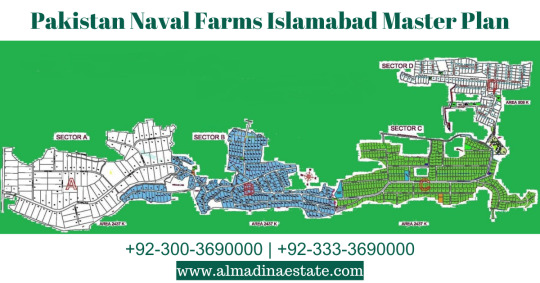
Naval Farms Islamabad Payment Plan:
Pakistan Naval Farms has been meticulously planned with a keen focus on its location. The Pakistan Navy deliberately selected a vast area spanning 10,000 kanal for this project. The housing scheme comprises primarily five blocks, namely Blocks A, B, C, D, and E. Blocks A to C are fully developed, offering available possessions to interested buyers. However, Naval Farms Islamabad Blocks D and E are currently undeveloped, awaiting future development initiatives.
Pakistan Naval Farms prices are as follows:
There are different plot sizes available in Naval Farms Blocks A, B, and C, which include 5 kanal, 8 kanal, 10 kanal, 12 kanal, 20 kanal, and even bigger farmhouse plots.
- Block A: 20 Kanal farmhouse plots, with prices ranging from 15 crore to 20 crore.
- In Block B, 8 Kanal farmhouse plots are available, with prices ranging from 7.50 crore to 9.00 crore.
- In Block B, 5 Kanal farmhouse plots are available, with prices ranging from 4.50 crore to 5.50 crore.
- In Block C, 5 Kanal farmhouse plots are available, with prices ranging from 4.50 crore to 5 crore.
On the other hand, only files are available for Naval Farms Islamabad Block D and Block E.
- In Block D, which is currently non-developed, 5 kanal non-possession plots are available, with prices starting from 3.25 crore up to 4.75 crore.
-
In Block E, which is currently non-ballot, 5 kanal (file) prices start from 1.85 crore up to 1.90 crore.
Currently, the administration of Pakistan Naval Farm Houses has not introduced any official installment plan for farmhouse purchases. However, there is a possibility of such a plan being introduced in the future. At present, buyers are required to make full upfront payments for the purchase of farmhouse land or built-up farmhouses.
Features and Amenities:
Pakistan Naval Farm Houses offers a comprehensive range of modern facilities and amenities, comparable to those found in prestigious developments like DHA. Managed and owned by the Pakistan Navy, it is committed to delivering top-notch services to its residents. Naval Farm Houses Islamabad is anticipated to exceed expectations in terms of modernization and convenience. According to officials, the project will provide all the essential basic and modern amenities required for a contemporary lifestyle.
At Pakistan Naval Farms, residents enjoy a comprehensive array of both basic and modern facilities and amenities, ensuring a comfortable and convenient lifestyle.
- A main boulevard boasts an impressive width of 80 feet, complemented by streets and service roads ranging from 40 to 60 feet in width.
- A complete underground sewerage system contributes to a clean and hygienic environment.
- Round-the-clock security services are provided to safeguard the community.
- Continuous freshwater supply for the residents' daily needs.
- Reliable electricity supply to ensure uninterrupted power availability.
-
Internet connectivity is provided by PTCL and Nayatel.
- Gas pipelines are laid throughout the farmhouse area, enhancing convenience for residents.
- Access to hospitals and healthcare facilities to cater to medical needs.
- A green hiking trail for outdoor enthusiasts seeking adventure and recreation.
- The Navy Club House offers a myriad of family, children, and solo activities, including wedding halls, swimming pools, guest rooms, and indoor sports and games facilities.
These essential amenities collectively contribute to making Naval Farms Islamabad a serene and well-maintained residential enclave, fostering a peaceful lifestyle for its residents.
Conclusion:
In conclusion, Pakistan Naval Farms Islamabad emerges as a distinguished residential project that epitomizes luxury, comfort, and modern living. Pakistan Naval Farms Islamabad offers residents a serene lifestyle amidst Islamabad's natural beauty. With lush green surroundings, top-notch facilities, and secure investment, it stands as a beacon of real estate excellence.
Read the full article
#farmhouseforsaleinnavalanchorageislamabad#farmhouseforsaleinnavalfarmsislamabad#Farmhouseforsale#FarmhouseforsaleinIslamabad#FarmhouseforsaleinIslamabadoninstallments#navalanchoragefarmhousesislamabad#navalfarmhouseforsaleinislamabad#navalfarmhouseislamabad#navalfarmhousesislamabad#navalfarmsislamabad#navalfarmsislamabadforsale#pakistannavalfarmsislamabad#pakistannavalfarmsphaseiislamabad#pakistannavyfarmsislamabad#pnfarmsislamabadforsale
0 notes
Text









Toyota Land Cruiser ZX
Model 2016
Import 2021
Register 2022
Islamabad Register
Mileage: 20,000 KM
Color Pearl White
Bruno Interior
Full House
Accessories
1. Front Radar
2. Cool Box
3. Original Tv with 360 Degree Camera
4. Diamond Cut Seats
5. Line Assist
6. Auto Boot
7. Air Suspension
8. Black Shaded Front Lights
9. Heating Steering
10. Heating and cooling Seats
11. Wireless Mobile Charger
12. Four Zone Automatic Climate Control
13. Reinforce Skid Plates
14. Star Safety System
15. Advance 10 Airbag System
16. Toyota Safety Sensor
17. JBL System 14 Speakers
Contact:- Hammad Mansoor
Sigma Motors Lahore: 382-E Main Boulevard near Allah Ho Chowk Johar Town.
- - - - - - - - - - - - - -
Instagram / Facebook / TikTok / Twitter / Tumblr / YouTube: Sigma Motors
- - - - - - - - - - - - - -
0 notes
Text
Miss Hina Escort service Islamabad available h
My phone number 03180549520
Service night Short body to body massage hand massage sucking licking lips kissing boobs sucking boobs licking hot sex hot girls kapel sex group sex kame sex lips kissing VIP model girls Islamabad Rawalpindi Bahria Town service 24 hour available Hai


3 notes
·
View notes
Text
Rats Trapping, Deemak Termite Control Services & Pest Control Services Islamabad Lahore
Searching for Pest Control Near Me? As an Exterminator Pest control team in Islamabad, Lahore, we offer Deemak Control, Termite Control Services, Pest Control Services, Fumigation Spray Services, Bed Bug Infestation Treatment, Cockroach Control Services, Rats Trapping Services, and Termite Proofing Spray for Termites treatment. 😲
#PestControlServicesInLahore #DeemakControlInLahore #TermiteControlServicesInLahore #PestControlServices #PestControlIslamabad #TermiteControlIslamabad #FumigationSprayServicesIslamabad #PestControlNearMe #ExterminatorInLahore #HerbalPestControlCharges #BedBugInfestationTreatment #BedBugsKillerSprayServices #CockroachKillerSpray #CockroachControlServices #RatsTrappingServices #RatKillPoison #TermiteProofingSprayForTermites #FumigationServicesInRawalpindi #IntegratedPestManagement #SanitizationDisinfectionServices #SofaCleaningServicesInIslamabad #DengueSprayInLahoreIslamabad #MosquitoKillerSpray #PestManagementServicesInLahore
Web: https://hafizpestcontrol.com/ 👈
Phone: +92 300 4888279 😍

### Deemak Pest Control Services in Lahore By HafizPestControl ###
As an Exterminator pest management team, we, the Hafiz Pest Control Company, provide Pest Control Services in Lahore, Deemak Control in Lahore, and Termite Control Services in Lahore
## Our Pest Control Services Includes: ##
Pest Control Services in Lahore
Deemak Control in Lahore
Termite Control Services in Lahore
Pest Control Services
Pest Control Islamabad
Termite Control Islamabad
Fumigation Spray Services Islamabad
Pest Control Near Me
Exterminator in Lahore
Herbal Pest Control Charges
Bed Bug Infestation Treatment
Bed Bugs Killer Spray Services
Cockroach Killer Spray
Cockroach Control Services
Rats Trapping Services
Rat Kill Poison
Termite Proofing Spray for Termites
Fumigation Services in Rawalpindi
Integrated Pest Management
Sanitization Disinfection Services
Sofa Cleaning Services in Islamabad
Dengue Spray in Lahore Islamabad
Mosquito Killer Spray
Pest Management Services in Lahore
Phone: +92 333 0138282 🆗
Q-Block, Model Town Extension, Lahore, Pakistan
#Pest Control Services in Lahore#Deemak Control in Lahore#Termite Control Services in Lahore#Pest Control Services#Pest Control Islamabad#Termite Control Islamabad#Fumigation Spray Services Islamabad#Pest Control Near Me#Exterminator in Lahore#Herbal Pest Control Charges#Bed Bug Infestation Treatment#Bed Bugs Killer Spray Services#Cockroach Killer Spray#Cockroach Control Services#Rats Trapping Services#Rat Kill Poison#Termite Proofing Spray for Termites#Fumigation Services in Rawalpindi#Integrated Pest Management#Sanitization Disinfection Services#Sofa Cleaning Services in Islamabad#Dengue Spray in Lahore Islamabad#Mosquito Killer Spray#Pest Management Services in Lahore#PestControlServicesInLahore#DeemakControlInLahore
0 notes
Text
Islamabad Model Town (Booking @20%)
3.5,5,7,10 Marla
1,2 Kanal Residencial Plots
Location is in between Bahria Enclave and Parkview City
Contact For Booking and Details
0333-8527798
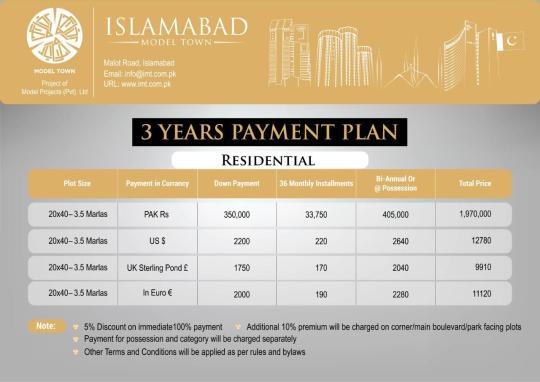


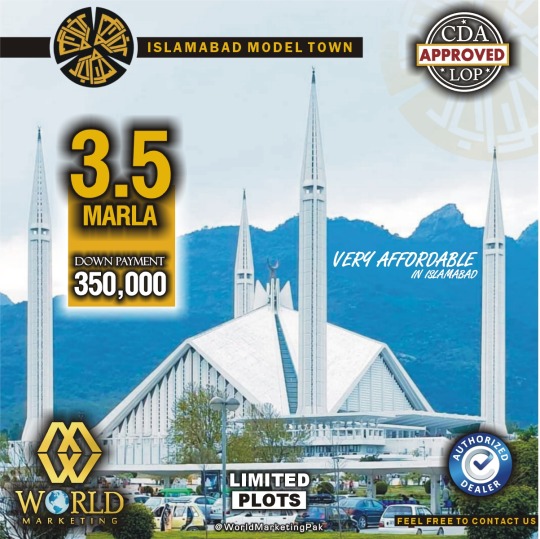
2 notes
·
View notes
Link
1 note
·
View note
Text
Highlights of the Blue World City
Highlights of the Blue World City
Presentation
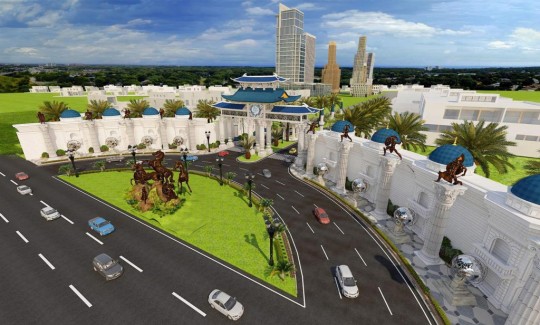
The Blue Group Of Companies right now possesses a blue World. It is situated between the Rawalpindi and the Islamabad City. It would be one of its lodging social orders. It is the main lodging society that is being built by the Chinese. It is one of the most reasonable lodging plans in Pakistan. The territory has gotten very famous among the speculators and the individuals who need to make their homes there.
Proprietor and Developers:
The proprietor and the venture engineers are Saad Nazir, the child of EX-Deputy Commissioner Lahore, who is Ch. Nazeer. The organization has additionally marked a MOU with the Shan Jian Municipal Engineering organization which is from China.
Highlights of the Blue World City:
All the highlights of the Blue World are coordinating International Standards. The squares are extraordinarily intended for individuals who need to have the most recent offices in their lodging social orders.
Savvy Security
Keen Building
Keen Transportation
Savvy Resource Management
Savvy Connectivity
Savvy Facilities
Tasks of the Blue World City:
Saad Nazir is one of the best land designers in Pakistan. He has developed PIA co-usable society, Blue Sapphire, Blue innovations, and Blue Mart. The most recent task is being dispatched under the umbrella of the Blue Group of organizations.
Subtleties of the Project:
The all out land covered by the task is around 5000 waterway, and the entire zone is additionally isolated into four stages. There are numerous squares and plots, additionally in the lodging plan. The general public is right now offering long term and four-year portion plans for its clients. The booking begins with a 10% initial installment, which is as low as Rs. 80,000/ –
Area of the Blue World:
The abroad square has direct access from the Charki Road. It has an assigned entryway that enters straightforwardly into the principle door of the general public. The venture likewise has direct access from the Rawalpindi Ring Road. This would straightforwardly associate The Blue World City Islamabad and the Motorway M-2 in the following two years. The venture is assembling a great deal of fascination from both the neighborhood just as worldwide financial specialists.
The city is right now found away from society’s hustle, which gives it an extraordinary and quiet climate.
There are likewise many neighboring towns and tourist spots close to the general public. These towns incorporate Top city, Khaniyal Homes, Star Argo ranches, and Mumtaz City.
Blue World City Map:
Numerous different towns and lodging plans as of now encompass the city. This is encircled by Chakri Road and Proposed Rawalpindi Ring Road.
Purposes of Access:
There are additionally many passageways coming into society. The general public can be gotten to by the Lahore_ Islamabad Motorway M-2 to the Chakri Road. On the off chance that you are going towards Islamabad, at that point it is available through the Ring Road. The Ring Road presently abbreviates the Travel time. This can likewise be utilized to go to territories like Bahria Enclave, Bahria Town Islamabad.
Blue Group of Companies (BGC):
The organization was established in 1989. The organization began by giving development and design administrations. The organization was before long begun to be perceived all over Pakistan for its quality and greatness. The organization is viewed as very dependable and expert The Company has caught the eye of numerous unfamiliar and nearby customers. The organization has ventured into numerous skylines at this moment and is presently zeroing in on making an incentive for some other land roads. The organization as of now offers Marketing, Architectural, Construction, IT, Support, and business printing. The organization has likewise right now entertained itself with different business roads, which are retail. The organization presently claims many garments and retail locations all over Pakistan.
Blue gathering of organizations has more than 300 experts that are working for them at this moment. This makes them the most broadened organization in Pakistan.
Blue World City Master Plan:
There is a proposed end-all strategy for the Blue World City which is given beneath:
Moza:
Sehal is the town of the Blue world, which is likewise its Moza.
Size of streets:
The streets of the Blue world are extremely open. This interfaces it to all pieces of society. These streets’ measurements are the principle street is 80 ft, and the roads are 40ft wide. Simultaneously, the primary road is 120 ft.
Ground breaking strategy of Blue World City
Developing urbanization, practical turn of events, computerized challenge, clients’ inclusion, monetary and social appeal, administration is important for the primary stakes urban areas need to handle. To confront this plural metropolitan reality, it has gotten important to discover adjusted intends to consider urban areas and regional turn of events. Better contemplations of the utilizations, the production of genuine discussion techniques have need.
Areas
At first, the administration has dispatched 2 areas that are simply hold for private reason. Notwithstanding, different regions will be revealed when the improvement work began on them. Declared squares are recorded underneath:
Squares of the Blocks:
Chief Block
Abroad Block
Private Block
Business Block
Blue Hills Farm Houses
Awami Complex Villas
Chief Block
The chief square is held for Pakistani occupants who wish to carry on with a savvy life. This square will be bound with all the contemporary conveniences that make life helpful. As of now, plots are offered in the accompanying classification
5 Marla
10 Marla
20 Marla
Over Seas block:
The blue world organization has additionally incorporated a square for the Overseas Pakistani that need to settle here. The square is turning into a focal point of fascination for the individuals who need to settle here and need to have a serene life. The square is extraordinarily intended for abroad Pakistani who needs to make a mind-blowing most can book a house at the abroad square of the Blue World. There are a set number of plots accessible in this square. So clients are given need dependent on the principal come or first-come premise.
5 Marla
10 Marla
20 Marla
Private Block:
Blue World City Islamabad is offering Residential Blocks for Public and Government Community.
Blue World City Apartments:
Blue World City has wonderful condo’s territory. We associate individuals with lofts, and it’s our objective to discover you the most lovely spot to live at the most perfect cost. We are here to remove the problem and stress from finding stunning condos in Blue World City.
Blue Hills Farm houses:
Blue World City ranch houses have sentiment of unadulterated living with contemporary comforts at entirely sensible cost rates.
Awami Complex Villas:
Blue World City set up a Block with the name of Awami Complex Villas. Blue World City realizes that Pakistan is a financial country, individuals can’t bear the cost of significant expense along these lines, and they remember and offer minimal effort houses for the simplicity of individuals.
Blue World City Houses:
Blue World City has present day houses, for example, no heap shedding, sterile water and dishwashing security which offer luxurious living models.
Structure of the Company:
The organization has a significant different portfolio and has the accompanying auxiliaries presently:
Brands Square
Blue Media
Shop Blue
Artimmix
WPZ
Blue Palms
Blue Technologies
Blue Bricks
Blue Properties
Offices and Amenities
The occupants of Blue World City will encounter a cutting edge method of living. One of the principle reasons is the arrangement of extreme offices and civilities in Lahore Smart City. Additionally, using the front line innovation guarantees all keen offices in this first world city of Pakistan.
Moreover, coming up next are the primary highlights of Blue World City that make it supreme.
Door Entries
Films
Emergency clinics
Mosques
Budgetary Square
Occasion Park
Instructive establishments
Stockrooms
18-opening green
5-Star Hotels and Restaurants
Transport and Public Transport (BRT) Stations
Shopping Mall and Complex
Amusement Parks and Bird Park
Burden Shedding free climate
CCTV with Facial and Object Recognition Cameras
Water and Sewerage Treatment Plant
NOC of the Blue World:
The Rawalpindi Development Authority has given a NOC to the Blue World, which is Vide Letter no. RDA/MP&TF/F-PHS-PTR-10/148. Dated: 19-02-2019. To begin with, around 427 channel development consent was truly, at that point around authorization of 5000 trenches was asked, which was allowed further to extend the lodging plan. The application is as yet under the cycle and is as of now being outlined by the RDA. The authorization for stage 1 is allowed. The circumstance is a lot of like that of Capital Smart City.
Why Blue World City is Smart City?
Blue World City is primarily based upon a selective Urban-administration. Resolved to guarantee ideal effectiveness and control, it likewise guarantees dynamic investment. Likewise, it’s endeavoring to get progressed Information and Communication Technology foundation that will prompt improved productivity and administrations.
Moreover, the fundamental point of this uber lodging plan is to inspire the expectations for everyday comforts while boosting monetary development in the locale. It’s a Grade-8 improvement alongside self-supporting Eco-Friendly methodology.
Ideal Elements
Additionally, Blue World City focal thought rotates around the accompanying 3 components
Brilliant Housing
Brilliant Economy
Brilliant Environment
Subtleties of every one of these components are shared beneath
Savvy Housing
Blue World City Islamabad endeavors to give quality and up to standard living experience. Besides, with cutting edge framework, it conveys a wide scope of administrations for each individual.
Shrewd Economy
Further, once being operational, this venture will hope to be one of the fundamental center points of monetary exercises in the area. As of now, it’s hypothesized as a uber business focus in the zone.
Brilliant Environment
The site is improved as far as Natural Scenic Beauty and Topography. 30% of the all out region held for regular resources. Besides, engineers likewise expanded their endeavors to maintain a strategic distance from the danger of harming characteristic landscape.
Installment Plans of the Blue world:
1 note
·
View note